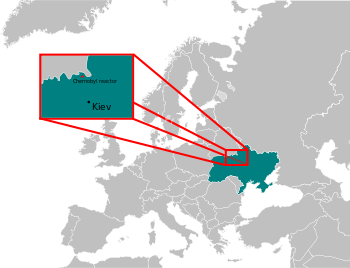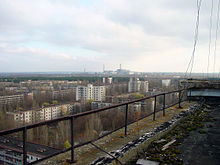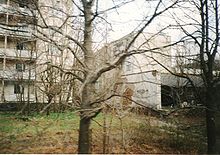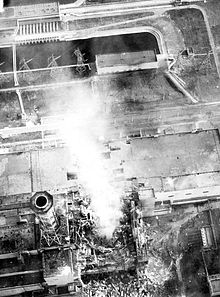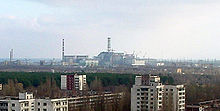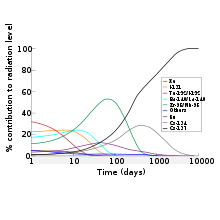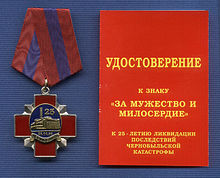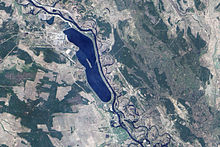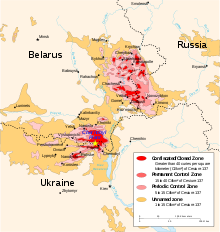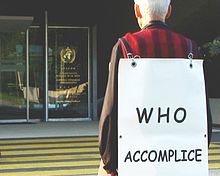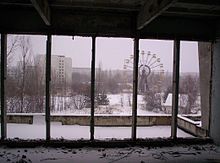- Chernobyl disaster
-
This article is about the 1986 nuclear plant accident in Ukraine. For other uses, see Chernobyl (disambiguation).
Chernobyl disaster 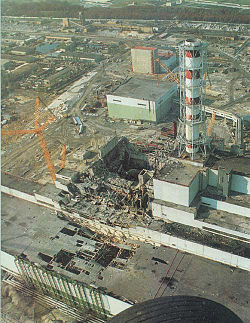 The nuclear reactor after the disaster. Reactor 4 (center). Turbine building (lower left). Reactor 3 (center right).
The nuclear reactor after the disaster. Reactor 4 (center). Turbine building (lower left). Reactor 3 (center right).Date 26 April 1986 Time 01:23 (Moscow Time UTC+3) Location Pripyat, Ukrainian SSR, Soviet Union, now Ukraine The Chernobyl disaster (locally Катастрофа Чернобыля, Chornobyl Catastrophe) was a nuclear accident that occurred on 26 April 1986 at the Chernobyl Nuclear Power Plant in Ukraine (officially Ukrainian SSR), which was under the direct jurisdiction of the central authorities in Moscow. An explosion and fire released large quantities of radioactive contamination into the atmosphere, which spread over much of Western USSR and Europe. It is considered the worst nuclear power plant accident in history, and is one of only two classified as a level 7 event on the International Nuclear Event Scale (the other being the Fukushima Daiichi nuclear disaster).[1] The battle to contain the contamination and avert a greater catastrophe ultimately involved over 500,000 workers and cost an estimated 18 billion rubles, crippling the Soviet economy.[2]
The disaster began during a systems test on Saturday, 26 April 1986 at reactor number four of the Chernobyl plant, which is near the city of Prypiat and within a close proximity to the administrative border with Belarus and Dnieper river. There was a sudden power output surge, and when an emergency shutdown was attempted, a more extreme spike in power output occurred, which led to a reactor vessel rupture and a series of explosions. These events exposed the graphite moderator of the reactor to air, causing it to ignite.[3] The resulting fire sent a plume of highly radioactive smoke fallout into the atmosphere and over an extensive geographical area, including Pripyat. The plume drifted over large parts of the western Soviet Union and Europe. From 1986 to 2000, 350,400 people were evacuated and resettled from the most severely contaminated areas of Belarus, Russia, and Ukraine.[4][5] According to official post-Soviet data,[6][7] about 60% of the fallout landed in Belarus.
The accident raised concerns about the safety of the Soviet nuclear power industry, as well as nuclear power in general, slowing its expansion for a number of years and forcing the Soviet government to become less secretive about its procedures.[8][notes 1] The government coverup of the Chernobyl disaster was a "catalyst" for glasnost, which "paved the way for reforms leading to the Soviet collapse."[9]
Russia, Ukraine, and Belarus have been burdened with the continuing and substantial decontamination and health care costs of the Chernobyl accident. A report of the International Atomic Energy Agency,[7] examines the environmental consequences of the accident. Estimates of the number of deaths potentially resulting from the accident vary enormously: Thirty one deaths are directly attributed to the accident, all among the reactor staff and emergency workers.[10] A UNSCEAR report places the total confirmed deaths from radiation at 64 as of 2008. The World Health Organization (WHO) suggests it could reach 4,000 civilian deaths, a figure which does not include military clean-up worker casualties.[11] A 2006 report predicted 30,000 to 60,000 cancer deaths as a result of Chernobyl fallout.[12] A Greenpeace report puts this figure at 200,000 or more.[13] A Russian publication, Chernobyl, concludes that 985,000 premature cancer deaths occurred worldwide between 1986 and 2004 as a result of radioactive contamination from Chernobyl.[14]
Accident
On 26 April 1986, at 01:23 (UTC+3), reactor four suffered a catastrophic power increase, leading to explosions in its core. This dispersed large quantities of radioactive fuel and core materials into the atmosphere[15]:73 and ignited the combustible graphite moderator. The burning graphite moderator increased the emission of radioactive particles, carried by the smoke, as the reactor had not been encased by any kind of hard containment vessel. The accident occurred during an experiment scheduled to test a potential safety emergency core cooling feature, which took place during the normal shutdown procedure.
The attempted experiment
Even when not actively generating power, nuclear power reactors require cooling, typically provided by coolant flow, to remove decay heat.[16] Pressurized water reactors use water flow at high pressure to remove waste heat. After an emergency shutdown (SCRAM), the core still generates a significant amount of residual heat, which is initially about seven percent of the total thermal output of the plant. If not removed by coolant systems, the heat could lead to core damage.[17][18] The reactor that exploded in Chernobyl consisted of about 1,600 individual fuel channels, and each operational channel required a flow of 28 metric tons (28,000 liters (7,400 USgal)) of water per hour.[15]:7 There had been concerns that in the event of a power grid failure, external power would not have been immediately available to run the plant's cooling water pumps. Chernobyl's reactors had three backup diesel generators. Each generator required 15 seconds to start up but took 60–75 seconds[15]:15 to attain full speed and reach the capacity of 5.5 MW required to run one main cooling water pump.[15]:30
This one-minute power gap was considered unacceptable, and it had been suggested that the rotational energy (or angular momentum) of the steam turbine and residual steam pressure (with turbine valves closed) could be used to generate electricity to run the main cooling water pumps while the emergency diesel generators were reaching the correct rotational speed (RPM) and voltage. In theory, analyses indicated that this residual momentum and steam pressure had the potential to provide power for 45 seconds,[15]:16 which would bridge the power gap between the onset of the external power failure and the full availability of electric power from the emergency generators. This capability still needed to be confirmed experimentally, and previous tests had ended unsuccessfully. An initial test carried out in 1982 showed that the excitation voltage of the turbine-generator was insufficient; it did not maintain the desired magnetic field after the turbine trip. The system was modified, and the test was repeated in 1984 but again proved unsuccessful. In 1985, the tests were attempted a third time but also yielded negative results. The test procedure was to be repeated again in 1986, and it was scheduled to take place during the maintenance shutdown of Reactor Four.[19]
The test focused on the switching sequences of the electrical supplies for the reactor. The test procedure was to begin with an automatic emergency shutdown. No detrimental effect on the safety of the reactor was anticipated, so the test program was not formally coordinated with either the chief designer of the reactor (NIKIET) or the scientific manager. Instead, it was approved only by the director of the plant (and even this approval was not consistent with established procedures). According to the test parameters, the thermal output of the reactor should have been no lower than 700 MW at the start of the experiment. If test conditions had been as planned, the procedure would almost certainly have been carried out safely; the eventual disaster resulted from attempts to boost the reactor output once the experiment had been started, which was inconsistent with approved procedure.[20]
The Chernobyl power plant had been in operation for two years without the capability to ride through the first 60–75 seconds of a total loss of electric power, and thus lacked an important safety feature. The station managers presumably wished to correct this at the first opportunity, which may explain why they continued the test even when serious problems arose, and why the requisite approval for the test had not been sought from the Soviet nuclear oversight regulator (even though there was a representative at the complex of 4 reactors).[notes 2]:18–20
The experimental procedure was intended to run as follows:
- The reactor was to be running at a low power level, between 700 MW and 800 MW.
- The steam-turbine generator was to be run up to full speed.
- When these conditions were achieved, the steam supply for the turbine generator was to be closed off.
- Turbine generator performance was to be recorded to determine whether it could provide the bridging power for coolant pumps until the emergency diesel generators were sequenced to start and provide power to the cooling pumps automatically.
- After the emergency generators reached normal operating speed and voltage, the turbine generator would be allowed to freewheel down.
Conditions prior to the accident
The conditions to run the test were established before the day shift of 25 April 1986. The day shift workers had been instructed in advance and were familiar with the established procedures. A special team of electrical engineers was present to test the new voltage regulating system.[21] As planned, a gradual reduction in the output of the power unit was begun at 01:06 on 25 April, and the power level had reached 50% of its nominal 3200 MW thermal level by the beginning of the day shift. At this point, another regional power station unexpectedly went offline, and the Kiev electrical grid controller requested that the further reduction of Chernobyl's output be postponed, as power was needed to satisfy the peak evening demand. The Chernobyl plant director agreed, and postponed the test.
At 23:04, the Kiev grid controller allowed the reactor shut-down to resume. This delay had some serious consequences: the day shift had long since departed, the evening shift was also preparing to leave, and the night shift would not take over until midnight, well into the job. According to plan, the test should have been finished during the day shift, and the night shift would only have had to maintain decay heat cooling systems in an otherwise shut down plant. The night shift had very limited time to prepare for and carry out the experiment. A further rapid reduction in the power level from 50% was executed during the shift change-over. Alexander Akimov was chief of the night shift, and Leonid Toptunov was the operator responsible for the reactor's operational regimen, including the movement of the control rods. Toptunov was a young engineer who had worked independently as a senior engineer for approximately three months.[15]:36–8
The test plan called for the power output of reactor 4 to be gradually reduced to a thermal level of 700–1000 MW.[22] The level established in the test program (700 MW) was achieved at 00:05 on 26 April; however, because of the natural production of the neutron absorber xenon-135 in the core, reactor power continued to decrease, even without further operator action (see reactor poisoning for details). As the power reached approximately 500 MW, Toptunov mistakenly inserted the control rods too far, bringing the reactor to an unintended near-shutdown state. The exact circumstances are hard to know, because both Akimov and Toptunov died from radiation sickness.
The reactor power dropped to 30 MW thermal (or less)—an almost completely shut down power level, which was approximately 5 percent of the minimum initial power level established as safe for the test.[20]:73 Control-room personnel consequently made the decision to restore the power by extracting the majority of the reactor control rods to the rods' upper limits.[23] Several minutes elapsed between their extraction and the point that the power output began to increase and subsequently stabilize at 160–200 MW (thermal), a much smaller value than the planned 700 MW. The rapid reduction in the power during the initial shutdown, and the subsequent operation at a level of less than 200 MW led to increased poisoning of the reactor core by the accumulation of xenon-135.[24][25] This restricted any further rise of reactor power, and made it necessary to extract additional control rods from the reactor core in order to counteract the poisoning.
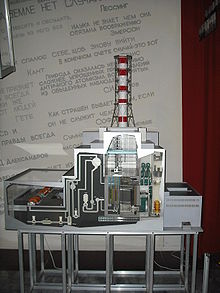 Chernobyl plant model on display at Kiev Ukrainian National Chernobyl Museum
Chernobyl plant model on display at Kiev Ukrainian National Chernobyl Museum
The operation of the reactor at the low power level and high poisoning level, was accompanied by unstable core temperature and coolant flow, and possibly by instability of neutron flux (see reactor poisoning). Various alarms started going off at this point. The control room received repeated emergency signals regarding the levels in the steam/water separator drums, and large excursions or variations in the flow rate of feed water, as well as from relief valves opened to relieve excess steam into a turbine condenser, and from the neutron power controller. In the period between 00:35 and 00:45, emergency alarm signals concerning thermal-hydraulic parameters were ignored, apparently to preserve the reactor power level. Emergency signals from the reactor emergency protection system (EPS-5) triggered a trip which turned off both turbine-generators.[26]
After a while, a more or less stable state at a power level of 200 MW was achieved, and preparation for the experiment continued. As part of the test plan, extra water pumps were activated at 01:05 on 26 April, increasing the water flow. The increased coolant flow rate through the reactor produced an increase in the inlet coolant temperature of the reactor core, which now more closely approached the nucleate boiling temperature of water, reducing the safety margin. The flow exceeded the allowed limit at 01:19. At the same time, the extra water flow lowered the overall core temperature and reduced the existing steam voids in the core.[27] Since water also absorbs neutrons (and the higher density of liquid water makes it a better absorber than steam), turning on additional pumps decreased the reactor power further still. This prompted the operators to remove the manual control rods further to maintain power.[28]
All these actions led to an extremely unstable reactor configuration. Nearly all of the control rods were removed, which would limit the value of the safety rods when initially inserted in a SCRAM condition. Further, the reactor coolant had reduced boiling, but had limited margin to boiling, so any power excursion would produce boiling, reducing neutron absorption by the water. The reactor was in an unstable configuration that was clearly outside the safe operating envelope established by the designers.
Experiment and explosion
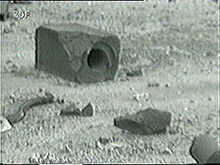 Lumps of graphite moderator ejected from the core. The largest lump shows an intact control rod channel.
Lumps of graphite moderator ejected from the core. The largest lump shows an intact control rod channel.
At 1:23:04 a.m. the experiment began. Four (of eight total) Main Circulating Pumps (MCP) were active. The steam to the turbines was shut off, and a run down of the turbine generator began. The diesel generator started and sequentially picked up loads, which was complete by 01:23:43. During this period, the power for the four MCPs was supplied by the turbine generator as it coasted down. As the momentum of the turbine generator decreased, the water flow rate decreased, leading to increased formation of steam voids (bubbles) in the core. Because of the positive void coefficient of the RBMK reactor at low reactor power levels, it was now primed to embark on a positive feedback loop, in which the formation of steam voids reduced the ability of the liquid water coolant to absorb neutrons, which in turn increased the reactor's power output. This caused yet more water to flash into steam, giving yet a further power increase. However, during almost the entire period of the experiment the automatic control system successfully counteracted this positive feedback, continuously inserting control rods into the reactor core to limit the power rise.
At 1:23:40, as recorded by the SKALA centralized control system, an emergency shutdown of the reactor, which inadvertently triggered the explosion, was initiated. The SCRAM was started when the EPS-5 button (also known as the AZ-5 button) of the reactor emergency protection system was pressed: this fully inserted all control rods, including the manual control rods that had been incautiously withdrawn earlier. The reason why the EPS-5 button was pressed is not known, whether it was done as an emergency measure or simply as a routine method of shutting down the reactor upon completion of the experiment. There is a view[who?] that the SCRAM may have been ordered as a response to the unexpected rapid power increase, although there is no recorded data conclusively proving this. Some[who?] have suggested that the button was not pressed, and instead the signal was automatically produced by the emergency protection system; however, the SKALA clearly registered a manual SCRAM signal. In spite of this, the question as to when or even whether the EPS-5 button was pressed has been the subject of debate. There are assertions[who?] that the pressure was caused by the rapid power acceleration at the start, and allegations that the button was not pressed until the reactor began to self-destruct but others assert that it happened earlier and in calm conditions.[29]:578[30] After the EPS-5 button was pressed, the insertion of control rods into the reactor core began. The control rod insertion mechanism moved the rods at 0.4 m/s, so that the rods took 18 to 20 seconds to travel the full height of the core, about 7 meters. A bigger problem was a flawed graphite-tip control rod design, which initially displaced coolant before inserting neutron-absorbing material to slow the reaction. As a result, the SCRAM actually increased the reaction rate in the lower half of the core.
A few seconds after the start of the SCRAM, a massive power spike occurred, the core overheated, and seconds later this overheating resulted in the initial explosion. Some of the fuel rods fractured, blocking the control rod columns and causing the control rods to become stuck at one-third insertion. Within three seconds the reactor output rose above 530 MW.[15]:31 The subsequent course of events was not registered by instruments: it is known only as a result of mathematical simulation. Apparently, a great rise in power first caused an increase in fuel temperature and massive steam buildup, leading to a rapid increase in steam pressure. This destroyed fuel elements and ruptured the channels in which these elements were located.[31] Then, according to some estimations[who?], the reactor jumped to around 30 GW thermal, ten times the normal operational output. The last reading on the control panel was 33 GW. It was not possible to reconstruct the precise sequence of the processes that led to the destruction of the reactor and the power unit building, but a steam explosion, like the explosion of a steam boiler from excess vapor pressure, appears to have been the next event. There is a general understanding that it was steam from the wrecked channels entering the reactor's inner structure that caused the destruction of the reactor casing, tearing off and lifting the 2,000-ton upper plate, to which the entire reactor assembly is fastened. Apparently, this was the first explosion that many[who?] heard.[32]:366 This explosion ruptured further fuel channels, and as a result the remaining coolant flashed to steam and escaped the reactor core. The total water loss in combination with a high positive void coefficient further increased the reactor power.
A second, more powerful explosion occurred about two or three seconds after the first; evidence indicates that the second explosion resulted from a nuclear excursion.[33] The nuclear excursion dispersed the core and effectively terminated the nuclear chain reaction. However, a graphite fire was burning by now, greatly contributing to the spread of radioactive material and the contamination of outlying areas[where?].[34] There were initially several hypotheses about the nature of the second explosion. One view was that "the second explosion was caused by the hydrogen which had been produced either by the overheated steam-zirconium reaction or by the reaction of red-hot graphite with steam that produced hydrogen and carbon monoxide." Another hypothesis was that the second explosion was a thermal explosion of the reactor as a result of the uncontrollable escape of fast neutrons caused by the complete water loss in the reactor core.[35] A third hypothesis was that the explosion was caused by steam. According to this version, the flow of steam and the steam pressure caused all the destruction that followed the ejection from the shaft of a substantial part of the graphite and fuel.
According to observers outside Unit 4, burning lumps of material and sparks shot into the air above the reactor. Some of them fell on to the roof of the machine hall and started a fire. About 25 percent of the red-hot graphite blocks and overheated material from the fuel channels was ejected. ...Parts of the graphite blocks and fuel channels were out of the reactor building. ...As a result of the damage to the building an airflow through the core was established by the high temperature of the core. The air ignited the hot graphite and started a graphite fire.[15]:32However, the ratio of xenon radioisotopes released during the event indicates that the second explosion could be a nuclear power transient. This nuclear transient released 40 GJ of energy, the equivalent of about ten tons of TNT. The analysis indicates that the nuclear excursion was limited to a small portion of the core.[33]
Contrary to safety regulations, bitumen, a combustible material, had been used in the construction of the roof of the reactor building and the turbine hall. Ejected material ignited at least five fires on the roof of the adjacent reactor 3, which was still operating. It was imperative to put those fires out and protect the cooling systems of reactor 3.[15]:42 Inside reactor 3, the chief of the night shift, Yuri Bagdasarov, wanted to shut down the reactor immediately, but chief engineer Nikolai Fomin would not allow this.[why?] The operators were given respirators and potassium iodide tablets and told to continue working. At 05:00, however, Bagdasarov made his own decision to shut down the reactor, leaving only those operators there who had to work the emergency cooling systems.[15]:44
Radiation levels
Approximate radiation levels at different locations shortly after the explosion were as follows:[36][not in citation given]
Location Radiation (Roentgens per hour) Sieverts per hour (SI Unit) Vicinity of the reactor core 30,000 300 Fuel fragments 15,000–20,000 150–200 Debris heap at the place of circulation pumps 10,000 100 Debris near the electrolyzers 5,000–15,000 50–150 Water in the Level +25 feedwater room 5,000 50 Level 0 of the turbine hall 500–15,000 5–150 Area of the affected unit 1,000–1,500 10–15 Water in Room 712 1,000 10 Control room, shortly after explosion 3–5 0.03–0.05 Gidroelektromontazh depot 30 0.3 Nearby concrete mixing unit 10–15 0.10–0.15 Plant layout
- Based on the image of the plant[37]
Level Objects Metres Levels are distances above (or below for minus values) ground level at the site. 49.6 Roof of the reactor building, gallery of the refueling mechanism 39.9 Roof of the deaerator gallery 35.5 Floor of the main reactor hall 31.6 Upper side of the upper biological shield, floor of the space for pipes to steam separators 28.3 Lower side of the turbine hall roof 24.0 Deaerator floor, measurement and control instruments room 16.4 Floor of the pipe aisle in the deaerator gallery 12.0 Main floor of the turbine hall, floor of the main circulation pump motor compartments 10.0 Control room, floor under the reactor lower biological shield, main circulation pumps 6.0 Steam distribution corridor 2.2 Upper pressure suppression pool 0.0 Ground level; house switchgear, turbine hall level −0.5 Lower pressure suppression pool −5.2, −4.2 Other turbine hall levels −6.5 Basement floor of the turbine hall Individual involvement
Main article: Individual involvement in the Chernobyl disasterImmediate crisis management
Radiation levels
The radiation levels in the worst-hit areas of the reactor building have been estimated to be 5.6 roentgens per second (R/s) (1.4 milliamperes per kilogram), equivalent to more than 20,000 roentgens per hour. A lethal dose is around 500 roentgens (0.13 coulombs per kilogram) over 5 hours, so in some areas, unprotected workers received fatal doses within minutes. However, a dosimeter capable of measuring up to 1,000 R/s (0.3 A/kg) was inaccessible because of the explosion, and another one failed when turned on. All remaining dosimeters had limits of 0.001 R/s (0.3 µA/kg) and therefore read "off scale." Thus, the reactor crew could ascertain only that the radiation levels were somewhere above 0.001 R/s (3.6 R/h, or 0.3 µA/kg), while the true levels were much, much higher in some areas.[15]:42–50
Because of the inaccurate low readings, the reactor crew chief Alexander Akimov assumed that the reactor was intact. The evidence of pieces of graphite and reactor fuel lying around the building was ignored, and the readings of another dosimeter brought in by 04:30 were dismissed under the assumption that the new dosimeter must have been defective.[15]:42–50 Akimov stayed with his crew in the reactor building until morning, trying to pump water into the reactor. None of them wore any protective gear. Most, including Akimov, died from radiation exposure within three weeks.[38]:247–48
Fire containment
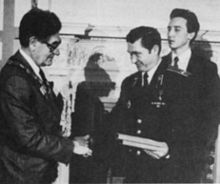 Firefighter Leonid Telyatnikov, being decorated for bravery
Firefighter Leonid Telyatnikov, being decorated for bravery
Shortly after the accident, firefighters arrived to try to extinguish the fires. First on the scene was a Chernobyl Power Station firefighter brigade under the command of Lieutenant Volodymyr Pravik, who died on 9 May 1986 of acute radiation sickness. They were not told how dangerously radioactive the smoke and the debris were, and may not even have known that the accident was anything more than a regular electrical fire: "We didn't know it was the reactor. No one had told us."[39]
Grigorii Khmel, the driver of one of the fire engines, later described what happened:
We arrived there at 10 or 15 minutes to two in the morning... We saw graphite scattered about. Misha asked: "Is that graphite?" I kicked it away. But one of the fighters on the other truck picked it up. "It's hot," he said. The pieces of graphite were of different sizes, some big, some small, enough to pick them up...
We didn't know much about radiation. Even those who worked there had no idea. There was no water left in the trucks. Misha filled a cistern and we aimed the water at the top. Then those boys who died went up to the roof—Vashchik, Kolya and others, and Volodya Pravik.... They went up the ladder ... and I never saw them again.[40]:54
However, Anatoli Zakharov, a fireman stationed in Chernobyl since 1980, offers a different description:
I remember joking to the others, "There must be an incredible amount of radiation here. We'll be lucky if we're all still alive in the morning."
Twenty years after the disaster, he said the firefighters from the Fire Station No. 2 were aware of the risks.
Of course we knew! If we'd followed regulations, we would never have gone near the reactor. But it was a moral obligation—our duty. We were like kamikaze.[41]
The immediate priority was to extinguish fires on the roof of the station and the area around the building containing Reactor No. 4 to protect No. 3 and keep its core cooling systems intact. The fires were extinguished by 5:00, but many firefighters received high doses of radiation. The fire inside reactor 4 continued to burn until 10 May 1986; it is possible that well over half of the graphite burned out.[15]:73 The fire was extinguished by a combined effort of helicopters dropping over 5,000 metric tons of sand, lead, clay, and neutron absorbing boron onto the burning reactor and injection of liquid nitrogen. The Ukrainian filmmaker Vladimir Shevchenko captured film footage of an Mi-8 helicopter as it collided with a nearby construction crane, causing the helicopter to fall near the damaged reactor building and killing its four-man crew.[42] It is now known that virtually none of the neutron absorbers reached the core.[43]
From eyewitness accounts of the firefighters involved before they died (as reported on the CBC television series Witness), one described his experience of the radiation as "tasting like metal," and feeling a sensation similar to that of pins and needles all over his face. (This is similar to the description given by Louis Slotin, a Manhattan Project physicist who died days after a fatal radiation overdose from a criticality accident.)[44]
The explosion and fire threw hot particles of the nuclear fuel and also far more dangerous fission products, radioactive isotopes such as caesium-137, iodine-131, strontium-90 and other radionuclides, into the air: the residents of the surrounding area observed the radioactive cloud on the night of the explosion.
Timeline
- 1:26:03 – fire alarm activated
- 1:28 – arrival of local firefighters, Pravik's guard
- 1:35 – arrival of firefighters from Pripyat, Kibenok's guard
- 1:40 – arrival of Telyatnikov
- 2:10 – turbine hall roof fire extinguished
- 2:30 – main reactor hall roof fires suppressed
- 3:30 – arrival of Kiev firefighters[45]
- 4:50 – fires mostly localized
- 6:35 – all fires extinguished‡[46]
‡With the exception of the fire contained inside Reactor 4, which continued to burn for many days.[15]:73
Evacuation developments
The nearby city of Prypiat was not immediately evacuated after the incident, for the general population of the Soviet Union was not informed of the disaster until Monday, April 28, 2 days later, with a 20 second announcement in the TV news program Vremya.[47] At that time ABC released its report about the disaster.[48] During that time, all radio broadcasts run by the state were replaced with classical music, which was a common method of preparing the public for an announcement of a tragedy that had taken place. Scientist teams were armed and placed on alert as instructions were awaited.
Only after radiation levels set off alarms at the Forsmark Nuclear Power Plant in Sweden,[49] over one thousand kilometers from the Chernobyl Plant, did the Soviet Union admit that an accident had occurred. Nevertheless, authorities attempted to conceal the scale of the disaster. For example, after evacuating the city of Prypiat, the following warning message was read on the state TV:
“ There has been an accident at the Chernobyl Nuclear Power Plant. One of the nuclear reactors was damaged. The effects of the accident are being remedied. Assistance has been provided for any affected people. An investigative commission has been set up. ” A state commission was set up the same day (April 26) and tasked with investigating the accident. It was headed by Valery Legasov, who arrived at Chernobyl in the evening of 26 April. By the time Legasov arrived, two people had already died and 52 were receiving medical attention in hospital. By the night of 26–27 April – more than 24 hours after the explosion – Legasov's committee had ample evidence that extremely high levels of radiation had caused a number of cases of radiation exposure. Based on the evidence at hand, Legasov's committee acknowledged the destruction of the reactor and ordered the evacuation of Pripyat.
The evacuation began at 14:00 on 27 April. In order to expedite the evacuation, the residents were told to bring only what was necessary, as the authorities had said it would only last approximately three days. As a result, most of the residents left their personal belongings, which are still there today. An exclusion zone of 30 km (19 mi) remains in place today, although its shape has changed and its size has been expanded.
As the plant was run by authorities in Moscow, the government of Ukraine did not receive prompt information on the situation at the site, according to the former chairman of Presidium of Verkhovna Rada of Ukrainian SSR, Valentyna Shevchenko.[50] In her recollections she stated that she was at work when at 09:00 Vasyl Durdynets who performed duties of the Minister of Internal Affairs at the time (as the First Deputy Minister) called in with a report on the recent situation, adding at the end that there was a fire at the Chernobyl AES (AES - an abbreviation for a nuclear power plant), which was extinguished and everything was fine (see Fire containment). When Shevchenko asked "How are the people?", he replied that there was nothing to be concerned with: "some are celebrating a wedding, others are gardening, and others are fishing in the Pripyat River".[50] On April 25, 2011 the President of Ukraine Viktor Yanukovych awarded Durdynets the "Distinguished Juror of Ukraine" as an advisor of the Ministry of Internal Affairs, a participant in the liquidation of consequences of Chernobyl disaster, and a general of Internal Service of Ukraine.[51] After the report Shevchenko called in to Volodymyr Shcherbytsky (Head of the Central Committee of CP(b)U, de facto - a head of state).[50] Shcherbytsky stated that he anticipated a delegation of the state commission headed by the deputy chairman of the Council of Ministers of USSR.[50]
Among the delegation's officials were academic Evgeny Velikhov, a leading nuclear specialist in the Soviet Union; a head of Hydro-Meteorologic Service of USSR Yuriy Izrael; a chief radiologist of the country Leonid Ilyin; and others.[50] Right after the Boryspil International Airport the delegation drove to the power plant and already at night realizing the seriousness of the situation decided to evacuate the residents of Prypiat.[50] On April 26, 2011 Velikhov was awarded Order of Merit of the III degree from the President of Ukraine Viktor Yanukovych for his contributions in the liquidation of consequences of the Chernobyl disaster.[52]
By the morning of April 27 numerous buses arrived in Prypiat to start the evacuation which lasted from 11:00. By 15:00 53,000 people were evacuated to various villages of Kiev region.[50] At first it was decided to evacuate the population temporarily for three days, however later it was postponed permanently.[50] Many took only the most necessary items and their documents leaving all the rest behind.[50] The next day there were initiated talks to evacuate people from the 10 km zone.
Shevchenko was the first from the Ukrainian state top officials who arrived to the disaster's site early on April 28.[50] There she spoke with members of medical staff and people.[50] People were calm and hopeful to return soon to their homes.[50] Shevchenko returned home late near midnight stopping at a radiological checkpoint in Vilcha, that was one of the first which were set up soon after the accident.[50]
There was a notification from Moscow that there is no reason to postpone the May 1 celebrations (including the annual parade), however on April 30 a meeting of the Political bureau of the Central Committee of CP(b)U took place to discuss the plan for the upcoming celebration.[50] Scientists were reporting that the radiological background in Kiev city currently is normal.[50] At the meeting, which was finished at 18:00, it was decided to shorten celebrations from the regular 3.5-4 to under 2 hours.[50] All republican leaders must be at their working place as there was anticipation for the arrival of Moscow's officials.[50]
Steam explosion risk
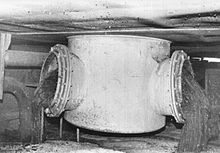 Chernobyl corium lava flows formed by fuel-containing mass in the basement of the plant. Lava flow (1). Concrete (2). Steam pipe (3). Electrical equipment (4).[53]
Chernobyl corium lava flows formed by fuel-containing mass in the basement of the plant. Lava flow (1). Concrete (2). Steam pipe (3). Electrical equipment (4).[53]
Two floors of bubbler pools beneath the reactor served as a large water reservoir for the emergency cooling pumps and as a pressure suppression system capable of condensing steam in case of a small broken steam pipe; the third floor above them, below the reactor, served as a steam tunnel. The steam released by a broken pipe was supposed to enter the steam tunnel and be led into the pools to bubble through a layer of water. The pools and the basement were flooded because of ruptured cooling water pipes and accumulated firefighting water. They now constituted a serious steam explosion risk. The smoldering graphite, fuel and other material above, at more than 1200 °C,[54] started to burn through the reactor floor and mixed with molten concrete from the reactor lining, creating corium, a radioactive semi-liquid material comparable to lava.[53][55] If this mixture had melted through the floor into the pool of water, it was feared it could have created a serious steam explosion that would have ejected more radioactive material from the reactor. It became necessary to drain the pool.[56]
The bubbler pool could be drained by opening its sluice gates. Volunteers in diving suits entered the radioactive water and managed to open the gates. These were the engineers Alexei Ananenko (who knew where the valves were) and Valeri Bezpalov, accompanied by a third man, Boris Baranov, who provided them with light from a lamp, though this lamp failed, leaving them to find the valves by feeling their way along a pipe. All of them returned to the surface and according to Ananenko, their colleagues jumped for joy when they heard they had managed to open the valves. Despite their good condition after completion of the task, all of them suffered from radiation sickness, and at least two—Ananenko and Bezpalov—later died.[citation needed] Some sources claim incorrectly that they died in the plant.[57] It is likely that intense alpha radiation hydrolyzed the water, generating a low-pH hydrogen peroxide (H2O2) solution akin to an oxidizing acid.[58] Conversion of bubbler pool water to H2O2 is confirmed by the presence in the Chernobyl lavas of studtite and metastudtite,[59][60] the only minerals that contain peroxide.[61]
Fire brigade pumps were then used to drain the basement. The operation was not completed until 8 May, after 20,000 metric tons of highly radioactive water were pumped out.
With the bubbler pool gone, a meltdown was less likely to produce a powerful steam explosion. To do so, the molten core would now have to reach the water table below the reactor. To reduce the likelihood of this, it was decided to freeze the earth beneath the reactor, which would also stabilize the foundations. Using oil drilling equipment, the injection of liquid nitrogen began on 4 May. It was estimated that 25 metric tons of liquid nitrogen per day would be required to keep the soil frozen at −100 °C.[15]:59 This idea[clarification needed] was soon scrapped and the bottom room where the cooling system would have been installed was filled with concrete.
Debris removal
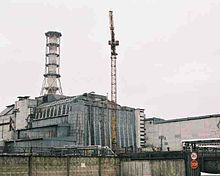 Chernobyl power plant in 2003 with the sarcophagus containment structure
Chernobyl power plant in 2003 with the sarcophagus containment structure
The worst of the radioactive debris was collected inside what was left of the reactor, much of it shoveled in by liquidators wearing heavy protective gear (dubbed "bio-robots" by the military); these workers could only spend a maximum of 40 seconds at a time working on the rooftops of the surrounding buildings because of the extremely high doses of radiation given off by the blocks of graphite and other debris. The reactor itself was covered with bags of sand, lead, and boric acid dropped from helicopters: some 5,000 metric tons of material were dropped during the week that followed the accident. At the time there was still fear that the reactor could re-enter a self-sustaining nuclear chain-reaction and explode again, and a new containment structure was planned to prevent rain entering and triggering such an explosion, and to prevent further release of radioactive material. This was the largest civil engineering task in history, involving a quarter of a million construction workers who all reached their official lifetime limits of radiation.[43] By December 1986, a large concrete sarcophagus had been erected to seal off the reactor and its contents.[62]
Many of the vehicles used by the "liquidators" remain parked in a field in the Chernobyl area.[63]
During the construction of the sarcophagus, a scientific team re-entered the reactor as part of an investigation dubbed "Complex Expedition", to locate and contain nuclear fuel in a way that could not lead to another explosion. These scientists manually collected cold fuel rods, but great heat was still emanating from the core. Rates of radiation in different parts of the building were monitored by drilling holes into the reactor and inserting long metal detector tubes. The scientists were exposed to high levels of radiation and radioactive dust. After six months of investigation, in December 1986, they discovered with the help of a remote camera an intensely radioactive mass in the basement of Unit Four, more than two metres wide and weighing hundreds of tons, which they called "the elephant's foot" for its wrinkled appearance. The mass was composed of sand, glass and a large amount of nuclear fuel that had escaped from the reactor. The concrete beneath the reactor was steaming hot, and was breached by solidified lava and spectacular unknown crystalline forms termed chernobylite. It was concluded that there was no further risk of explosion.[43]
Causes
Operator error initially faulted
There were two official explanations of the accident: the first, later acknowledged to be erroneous, was published in August 1986 and effectively placed the blame on the power plant operators. To investigate the causes of the accident the IAEA created a group known as the International Nuclear Safety Advisory Group (INSAG), which in its report of 1986, INSAG-1, on the whole also supported this view, based on the data provided by the Soviets and the oral statements of specialists.[64] In this view, the catastrophic accident was caused by gross violations of operating rules and regulations. "During preparation and testing of the turbine generator under run-down conditions using the auxiliary load, personnel disconnected a series of technical protection systems and breached the most important operational safety provisions for conducting a technical exercise."[65]:311 The operator error was probably due to their lack of knowledge of nuclear reactor physics and engineering, as well as lack of experience and training. According to these allegations, at the time of the accident the reactor was being operated with many key safety systems turned off, most notably the Emergency Core Cooling System (ECCS), LAR (Local Automatic control system), and AZ (emergency power reduction system). Personnel had an insufficiently detailed understanding of technical procedures involved with the nuclear reactor, and knowingly ignored regulations to speed test completion.[65]
The developers of the reactor plant considered this combination of events to be impossible and therefore did not allow for the creation of emergency protection systems capable of preventing the combination of events that led to the crisis, namely the intentional disabling of emergency protection equipment plus the violation of operating procedures. Thus the primary cause of the accident was the extremely improbable combination of rule infringement plus the operational routine allowed by the power station staff.[65]:312In this analysis of the causes of the accident, deficiencies in the reactor design and in the operating regulations that made the accident possible were set aside and mentioned only casually. Serious critical observations covered only general questions and did not address the specific reasons for the accident. The following general picture arose from these observations. Several procedural irregularities also helped to make the accident possible. One was insufficient communication between the safety officers and the operators in charge of the experiment being run that night. The reactor operators disabled safety systems down to the generators, which the test was really about. The main process computer, SKALA, was running in such a way that the main control computer could not shut down the reactor or even reduce power. Normally the reactor would have started to insert all of the control rods. The computer would have also started the "Emergency Core Protection System" that introduces 24 control rods into the active zone within 2.5 seconds, which is still slow by 1986 standards. All control was transferred from the process computer to the human operators.
This view is reflected in numerous publications and also artistic works on the theme of the Chernobyl accident that appeared immediately after the accident,[15] and for a long time remained dominant in the public consciousness and in popular publications.
Operating instructions and design deficiencies found
In 1991 a Commission of the USSR State Committee for the Supervision of Safety in Industry and Nuclear Power has reassessed the causes and circumstances of the Chernobyl accident and came to new insights and conclusions. Based on it, in 1992 the IAEA Nuclear Safety Advisory Group (INSAG) published an additional report, INSAG-7,[20] which reviewed "that part of the INSAG-1 report in which primary attention is given to the reasons for the accident." and included the USSR State Commission report as Appendix I. In this INSAG report, most of the earlier accusations against staff for breach of regulations were acknowledged to be either erroneous, based on incorrect information obtained in August 1986, or less relevant. This report reflected another view of the main reasons for the accident, presented in Appendix I. According to this account, the operators' actions in turning off the Emergency Core Cooling System, interfering with the settings on the protection equipment, and blocking the level and pressure in the separator drum did not contribute to the original cause of the accident and its magnitude, although they may have been a breach of regulations. Turning off the emergency system designed to prevent the two turbine generators from stopping was not a violation of regulations.[20]
Human factors contributed to the conditions that led to the disaster. These included operating the reactor at a low power level—less than 700 MW—a level documented in the run-down test program, and operating with a small operational reactivity margin (ORM). The 1986 assertions of Soviet experts notwithstanding, regulations did not prohibit operating the reactor at this low power level.[20]:18 However, regulations did forbid operating the reactor with a small margin of reactivity. Yet "post-accident studies have shown that the way in which the real role of the ORM is reflected in the Operating Procedures and design documentation for the RBMK-1000 is extremely contradictory," and furthermore, "ORM was not treated as an operational safety limit, violation of which could lead to an accident."[20]:34-25
According to the INSAG-7 Report, the chief reasons for the accident lie in the peculiarities of physics and in the construction of the reactor. There are two such reasons:[20]:18
- The reactor had a dangerously large positive void coefficient. The void coefficient is a measurement of how a reactor responds to increased steam formation in the water coolant. Most other reactor designs have a negative coefficient, i.e. the nuclear reaction rate slows when steam bubbles form in the coolant, since as the vapor phase in the reactor increases, fewer neutrons are slowed down. Faster neutrons are less likely to split uranium atoms, so the reactor produces less power (a negative feed-back). Chernobyl's RBMK reactor, however, used solid graphite as a neutron moderator to slow down the neutrons, and the water in it, on the contrary, acts like a harmful neutron absorber. Thus neutrons are slowed down even if steam bubbles form in the water. Furthermore, because steam absorbs neutrons much less readily than water, increasing the intensity of vaporization means that more neutrons are able to split uranium atoms, increasing the reactor's power output. This makes the RBMK design very unstable at low power levels, and prone to suddenly increasing energy production to a dangerous level. This behavior is counter-intuitive, and this property of the reactor was unknown to the crew.
- A more significant flaw was in the design of the control rods that are inserted into the reactor to slow down the reaction. In the RBMK reactor design, the lower part of each control rod was made of graphite and was 1.3 meters shorter than necessary, and in the space beneath the rods were hollow channels filled with water. The upper part of the rod, the truly functional part that absorbs the neutrons and thereby halts the reaction, was made of boron carbide. With this design, when the rods are inserted into the reactor from the uppermost position, the graphite parts initially displace some water (which absorbs neutrons, as mentioned above), effectively causing less neutrons to be absorbed initially. Thus for the first few seconds of control rod activation, reactor power output is increased, rather than reduced as desired. This behavior is counter-intuitive and was not known to the reactor operators.
- Other deficiencies besides these were noted in the RBMK-1000 reactor design, as were its non-compliance with accepted standards and with the requirements of nuclear reactor safety.
Both views were heavily lobbied by different groups, including the reactor's designers, power plant personnel, and the Soviet and Ukrainian governments. According to the IAEA's 1986 analysis, the main cause of the accident was the operators' actions. But according to the IAEA's 1993 revised analysis the main cause was the reactor's design.[66] One reason there were such contradictory viewpoints and so much debate about the causes of the Chernobyl accident was that the primary data covering the disaster, as registered by the instruments and sensors, were not completely published in the official sources.
Once again, the human factor had to be considered as a major element in causing the accident. INSAG notes that both the operating regulations and staff handled the disabling of the reactor protection easily enough: witness the length of time for which the ECCS was out of service while the reactor was operated at half power. INSAG’s view is that it was the operating crew's deviation from the test program that was mostly to blame. “Most reprehensibly, unapproved changes in the test procedure were deliberately made on the spot, although the plant was known to be in a very different condition from that intended for the test.”[20]:24
As in the previously released report INSAG-1, close attention is paid in report INSAG-7 to the inadequate (at the moment of the accident) “culture of safety” at all levels. Deficiency in the safety culture was inherent not only at the operational stage but also, and to no lesser extent, during activities at other stages in the lifetime of nuclear power plants (including design, engineering, construction, manufacture and regulation). The poor quality of operating procedures and instructions, and their conflicting character, put a heavy burden on the operating crew, including the Chief Engineer. “The accident can be said to have flowed from a deficient safety culture, not only at the Chernobyl plant, but throughout the Soviet design, operating and regulatory organizations for nuclear power that existed at that time.”[20]:24
Effects
Main article: Chernobyl disaster effectsInternational spread of radioactive substances
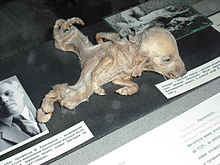 An exhibit at the Ukrainian National Chernobyl Museum. Mutations in both humans and other animals increased following the disaster. On farms in Narodychi district of Ukraine, for instance, in the first four years of the disaster nearly 350 animals were born with gross deformities such as missing or extra limbs, missing eyes, heads or ribs, or deformed skulls; in comparison, only three abnormal births had been registered in the five years prior.[67][68][69][70][71][72] Despite these claims, the World Health Organization states, "children conceived before or after their father's exposure showed no statistically significant differences in mutation frequencies." [73]
An exhibit at the Ukrainian National Chernobyl Museum. Mutations in both humans and other animals increased following the disaster. On farms in Narodychi district of Ukraine, for instance, in the first four years of the disaster nearly 350 animals were born with gross deformities such as missing or extra limbs, missing eyes, heads or ribs, or deformed skulls; in comparison, only three abnormal births had been registered in the five years prior.[67][68][69][70][71][72] Despite these claims, the World Health Organization states, "children conceived before or after their father's exposure showed no statistically significant differences in mutation frequencies." [73]
Four hundred times more radioactive material was released than had been by the atomic bombing of Hiroshima. The disaster released 1/100 to 1/1000 of the total amount of radioactivity released by nuclear weapons testing during the 1950s and 1960s.[74] Approximately 100,000 km² of land was contaminated with fallout, the worst hit regions being in Belarus, Ukraine and Russia.[75] Slighter levels of contamination were detected over all of Europe except for the Iberian Peninsula.[12][76][77]
The initial evidence that a major release of radioactive material was affecting other countries came not from Soviet sources, but from Sweden, where on the morning of 28 April[78] workers at the Forsmark Nuclear Power Plant (approximately 1,100 km (680 mi) from the Chernobyl site) were found to have radioactive particles on their clothes.[79] It was Sweden's search for the source of radioactivity, after they had determined there was no leak at the Swedish plant, that at noon on 28 April led to the first hint of a serious nuclear problem in the western Soviet Union. Hence the evacuation of Pripyat on 27 April, 36 hours after the initial explosions, was silently completed before the disaster became known outside the Soviet Union. The rise in radiation levels had at that time already been measured in Finland, but a civil service strike delayed the response and publication.[80]
Areas of Europe contaminated with 137Cs (km2)[81] Country 37–185 kBq/m2 185–555 kBq/m2 555–1480 kBq/m2 +1480 kBq/m2 Belarus 29 900 10 200 4 200 2 200 Ukraine 37 200 3 200 900 600 Russia 49 800 5 700 2 100 300 Sweden 12 000 - - - Finland 11 500 - - - Austria 8 600 - - - Norway 5 200 - - - Bulgaria 4 800 - - - Switzerland 1 300 - - - Greece 1 200 - - - Slovenia 300 - - - Italy 300 - - - Moldova 60 - - - Totals 162 160 19 100 7 200 3 100 Contamination from the Chernobyl accident was scattered irregularly depending on weather conditions, but rain was purposely seeded over the Byelorussian SSR by the Soviet air force to remove radioactive particles from clouds heading toward highly populated areas.[82] Reports from Soviet and Western scientists indicate that Belarus received about 60% of the contamination that fell on the former Soviet Union. However, the 2006 TORCH report stated that half of the volatile particles had landed outside Ukraine, Belarus, and Russia. A large area in Russia south of Bryansk was also contaminated, as were parts of northwestern Ukraine. Studies in surrounding countries indicate that over one million people could have been affected by radiation.[83]
Recently published data from a long-term monitoring program (The Korma Report)[84] shows a decrease in internal radiation exposure of the inhabitants of a region in Belarus close to Gomel. Resettlement may even be possible in prohibited areas provided that people comply with appropriate dietary rules.
In Western Europe, precautionary measures taken in response to the radiation included seemingly arbitrary regulations banning the importation of certain foods but not others. In France some officials stated that the Chernobyl accident had no adverse effects.[85] Official figures in southern Bavaria in Germany indicated that some wild plant species contained substantial levels of caesium, which were believed to have been passed onto them by wild boars, a significant number of which had already contained radioactive particles above the allowed level, consuming them.[clarification needed][86]
Radioactive release
Like many other releases of radioactivity into the environment, the Chernobyl release was controlled by the physical and chemical properties of the radioactive elements in the core. While the general population often perceives plutonium as a particularly dangerous nuclear fuel, its effects are almost eclipsed by those of its fission products. Particularly dangerous are highly radioactive compounds that accumulate in the food chain, such as some isotopes of iodine and strontium.
Two reports on the release of radioisotopes from the site were made available, one by the OSTI and a more detailed report by the OECD, both in 1998.[87][88] At different times after the accident, different isotopes were responsible for the majority of the external dose. The dose that was calculated is that received from external gamma irradiation for a person standing in the open. The dose to a person in a shelter or the internal dose is harder to estimate.
The release of radioisotopes from the nuclear fuel was largely controlled by their boiling points, and the majority of the radioactivity present in the core was retained in the reactor.
- All of the noble gases, including krypton and xenon, contained within the reactor were released immediately into the atmosphere by the first steam explosion.
- 55% of the radioactive iodine in the reactor, containing about 1760 PBq or 400 kg of I-131, was released, as a mixture of vapor, solid particles, and organic iodine compounds.
- Caesium (85 PBq Cs-137[89]) and tellurium were released in aerosol form.
- An early estimate for fuel material released to the environment was 3 ± 1.5%; this was later revised to 3.5 ± 0.5%. This corresponds to the atmospheric emission of 6 t of fragmented fuel.[88]
- Total atmospheric release is estimated at 5200 PBq.[90]
Two sizes of particles were released: small particles of 0.3 to 1.5 micrometers (aerodynamic diameter) and large particles of 10 micrometers. The large particles contained about 80% to 90% of the released nonvolatile radioisotopes zirconium-95, niobium-95, lanthanum-140, cerium-144 and the transuranic elements, including neptunium, plutonium and the minor actinides, embedded in a uranium oxide matrix.
Health of plant workers and local people
See also: Deaths due to the Chernobyl disasterIn the aftermath of the accident, 237 people suffered from acute radiation sickness (ARS), of whom 31 died within the first three months.[10][91] Most of these were fire and rescue workers trying to bring the accident under control, who were not fully aware of how dangerous exposure to the radiation in the smoke was. Whereas, in the World Health Organization's 2006 report of the Chernobyl Forum expert group on the 237 emergency workers who were diagnosed with ARS, ARS was identified as the cause of death for 28 of these people within the first few months after the disaster. There were no further deaths identified, in the general population affected by the disaster, as being caused by ARS. Of the 72,000 Russian Emergency Workers being studied, 216 non-cancer deaths are attributed to the disaster, between 1991 and 1998. The latency period for solid cancers caused by excess radiation exposure is 10 or more years; thus at the time of the WHO report being undertaken, the rates of solid cancer deaths were no greater than the general population. Some 135,000 people were evacuated from the area, including 50,000 from Pripyat.[citation needed]
Residual radioactivity in the environment
Rivers, lakes and reservoirs
The Chernobyl nuclear power plant is located next to the Pripyat River, which feeds into the Dnipro River reservoir system, one of the largest surface water systems in Europe. The radioactive contamination of aquatic systems therefore became a major problem in the immediate aftermath of the accident.[92] In the most affected areas of Ukraine, levels of radioactivity (particularly radioiodine: I-131, radiocaesium: Cs-137 and radiostrontium: Sr-90) in drinking water caused concern during the weeks and months after the accident. After this initial period, however, radioactivity in rivers and reservoirs was generally below guideline limits for safe drinking water.[92]
Bio-accumulation of radioactivity in fish[93] resulted in concentrations (both in western Europe and in the former Soviet Union) that in many cases were significantly above guideline maximum levels for consumption.[92] Guideline maximum levels for radiocaesium in fish vary from country to country but are approximately 1,000 Bq/kg in the European Union.[94] In the Kiev Reservoir in Ukraine, concentrations in fish were several thousand Bq/kg during the years after the accident.[93] In small "closed" lakes in Belarus and the Bryansk region of Russia, concentrations in a number of fish species varied from 100 to 60,000 Bq/kg during the period 1990–92.[95] The contamination of fish caused short-term concern in parts of the UK and Germany and in the long term (years rather than months) in the affected areas of Ukraine, Belarus, and Russia as well as in parts of Scandinavia.[92]
Groundwater
Groundwater was not badly affected by the Chernobyl accident since radionuclides with short half-lives decayed away long before they could affect groundwater supplies, and longer-lived radionuclides such as radiocaesium and radiostrontium were adsorbed to surface soils before they could transfer to groundwater.[96] However, significant transfers of radionuclides to groundwater have occurred from waste disposal sites in the 30 km (19 mi) exclusion zone around Chernobyl. Although there is a potential for transfer of radionuclides from these disposal sites off-site (i.e. out of the 30 km (19 mi) exclusion zone), the IAEA Chernobyl Report[96] argues that this is not significant in comparison to current levels of washout of surface-deposited radioactivity.
Flora and fauna
After the disaster, four square kilometers of pine forest directly downwind of the reactor turned reddish-brown and died, earning the name of the "Red Forest".[97] Some animals in the worst-hit areas also died or stopped reproducing. Most domestic animals were removed from the exclusion zone, but horses left on an island in the Pripyat River 6 km (4 mi) from the power plant died when their thyroid glands were destroyed by radiation doses of 150–200 Sv.[98] Some cattle on the same island died and those that survived were stunted because of thyroid damage. The next generation appeared to be normal.[98]
A robot sent into the reactor itself has returned with samples of black, melanin-rich radiotrophic fungi that are growing on the reactor's walls.[99]
Of the 440,350 wild boar killed in the 2010 hunting season in Germany, over 1,000 were found to be contaminated with levels of radiation above the permitted limit of 600 bequerels, due to residual radioactivity from Chernobyl.[100] Germany has "banned wild game meat because of contamination linked to radioactive mushrooms".[101]
The Norwegian Agricultural Authority reported that in 2009 a total of 18,000 livestock in Norway needed to be given uncontaminated feed for a period of time before slaughter in order to ensure that their meat was safe for human consumption. This was due to residual radioactivity from Chernobyl in the plants they graze on in the wild during the summer. The after-effects of Chernobyl were expected to be seen for a further 100 years, although the severity of the effects would decline over that period.[102] In Britain and Norway, as of 2011, "slaughter restrictions remain for sheep raised on pasture contaminated by radiation fallout".[101]
Assessing the disaster's effects on human health
Main article: Chernobyl disaster effectsAn international assessment of the health effects of the Chernobyl accident is contained in a series of reports by the United Nations Scientific Committee of the Effects of Atomic Radiation (UNSCEAR).[103] UNSCEAR was set up as a collaboration between various UN bodies, including the World Health Organisation, after the atomic bomb attacks on Hiroshima and Nagasaki, to assess the long-term effects of radiation on human health.
UNSCEAR has conducted 20 years of detailed scientific and epidemiological research on the effects of the Chernobyl accident. Apart from the 57 direct deaths in the accident itself, UNSCEAR predicted in 2005 based on Linear no-threshold model (LNT) that up to 4,000 additional cancer deaths related to the accident would appear "among the 600 000 persons receiving more significant exposures (liquidators working in 1986–87, evacuees, and residents of the most contaminated areas)".[104] Later this number was revised slightly up to 5,000. The number of excess deaths among 5 million people living in the less contaminated areas is estimated at 3,000–5,000. The number of excess cancer deaths worldwide (including all contaminated areas) is approximately 27,000 based on the same LNT.[105]
UNSCEAR now states:
Among the residents of Belarus, the Russian Federation and Ukraine, there had been up to the year 2005 more than 6,000 cases of thyroid cancer reported in children and adolescents who were exposed at the time of the accident, and more cases can be expected during the next decades. Notwithstanding the influence of enhanced screening regimes, many of those cancers were most likely caused by radiation exposures shortly after the accident. Apart from this increase, there is no evidence of a major public health impact attributable to radiation exposure two decades after the accident. There is no scientific evidence of increases in overall cancer incidence or mortality rates or in rates of non-malignant disorders that could be related to radiation exposure. The incidence of leukaemia in the general population, one of the main concerns owing to the shorter time expected between exposure and its occurrence compared with solid cancers, does not appear to be elevated. Although those most highly exposed individuals are at an increased risk of radiation-associated effects, the great majority of the population is not likely to experience serious health consequences as a result of radiation from the Chernobyl accident. Many other health problems have been noted in the populations that are not related to radiation exposure.[106]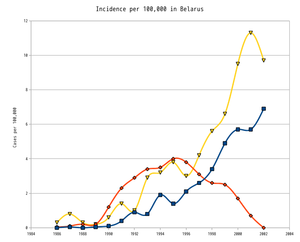 Thyroid cancer incidence in children and adolescents from Belarus after the Chernobyl accident.
Thyroid cancer incidence in children and adolescents from Belarus after the Chernobyl accident.
Yellow: Adults (19–34)
Blue: Adolescents (15–18)
Red: Children (0–14)However, thyroid cancer is generally treatable.[107] With proper treatment, the five-year survival rate of thyroid cancer is 96%, and 92% after 30 years,.[108] UNSCEAR counted 15 deaths from Thyroid cancer in the affected population.
In addition, the IAEA states that there has been no increase in the rate of birth defects or abnormalities, or solid cancers (such as lung cancer) corroborating UNSCEAR's assessments.[109] UNSCEAR does also raise the possibility of long term genetic defects, pointing to a doubling of radiation-induced minisatellite mutations among children born in 1994.[110] There is some dispute over the control groups in this study and the long term effects are not clear.
The Chernobyl Forum is a regular meeting of IAEA, other United Nations organizations (FAO, UN-OCHA, UNDP, UNEP, UNSCEAR, WHO, and the World Bank), and the governments of Belarus, Russia, and Ukraine that issues regular scientific assessments of the evidence for health effects of the Chernobyl accident.[111] The Chernobyl Forum concluded that twenty-eight emergency workers ("liquidators") died from acute radiation syndrome including beta burns and 15 patients died from thyroid cancer in the following years, and it roughly estimated that cancer deaths caused by Chernobyl may reach a total of about 4,000 among the 5 million persons residing in the contaminated areas, the report projected cancer mortality "increases of less than one per cent" (~0.3%) on a time span of 80 years, cautioning that this estimate was "speculative" since at this time only a few tens cancer deaths are linked to the Chernobyl disaster.[citation needed] Fred Mettler, a radiation expert at the University of New Mexico, puts this last number at "perhaps" 5000, for a total of 9000 Chernobyl associated fatal cancers, saying "the number is small (representing a few percent) relative to the normal spontaneous risk of cancer, but the numbers are large in absolute terms".[112] The same report outlined studies based in data found in the Russian Registry from 1991 to 1998 that suggested that "of 61,000 Russian workers exposed to an average dose of 107 mSv about 5% of all fatalities that occurred may have been due to radiation exposure."[citation needed]
The same report went into depth about the risks to mental health of exaggerated fears about the effects of radiation:[109]
The designation of the affected population as “victims” rather than “survivors” has led them to perceive themselves as helpless, weak and lacking control over their future. This, in turn, has led either to over cautious behavior and exaggerated health concerns, or to reckless conduct, such as consumption of mushrooms, berries and game from areas still designated as highly contaminated, overuse of alcohol and tobacco, and unprotected promiscuous sexual activity.[113]Fred Mettler commented that 20 years later:[114]
The population remains largely unsure of what the effects of radiation actually are and retain a sense of foreboding. A number of adolescents and young adults who have been exposed to modest or small amounts of radiation feel that they are somehow fatally flawed and there is no downside to using illicit drugs or having unprotected sex. To reverse such attitudes and behaviors will likely take years although some youth groups have begun programs that have promise.In addition, disadvantaged children around Chernobyl suffer from health problems that are attributable not only to the Chernobyl accident, but also to the poor state of post-Soviet health systems.[109]
A significant issue relating to problems establishing consistent data to base the analysis of the impact of the Chernobyl accident on the population at large is the social and political changes in the region since 1990. These have had numerous impacts in the administration of health care, on socio-economic stability, and even on the manner in which statistical data is collected. Some of these difficulties are outlined in the report "Cancer Mortality in Russia and Ukraine: Validity, Competing Risks and Cohort Effects",[115] which points out among other things that:
"...there is clear evidence of weaknesses in cause-of-death registration, especially among those >70 which has, historically, led to underestimation of cancer mortality especially in rural populations. Against this background, the rapid increase in cancer mortality among the elderly in Russia and Ukraine in the late 1980s and its striking further rise in Ukraine in 1989-1990 seems to be due, in large part, to an increase in completeness of registration of cancer as an underlying (or primary) cause of death. The decline in cancer mortality at older ages in the 1990s, which is particularly striking in Ukraine, seems likely to represent a return to previous approaches to registration."Another study critical of the Chernobyl Forum report was commissioned by Greenpeace, which asserts that "the most recently published figures indicate that in Belarus, Russia and Ukraine alone the accident could have resulted in an estimated 200,000 additional deaths in the period between 1990 and 2004."[13] The Scientific Secretary of the Chernobyl Forum criticized the report's exclusive reliance on non-peer reviewed locally produced studies (in fact, most of the study's sources are from peer-reviewed journals, including many Western medical journals, or from proceedings of scientific conferences[13]), while Gregory Härtl (spokesman for the WHO) suggested that the conclusions were motivated by ideology.[116]
The German affiliate of the International Physicians for the Prevention of Nuclear War (IPPNW) argued that more than 10,000 people are today affected by thyroid cancer and 50,000 cases are expected in the future.[117]
Chernobyl: Consequences of the Catastrophe for People and the Environment is an English translation of the 2007 Russian publication Chernobyl. It was published in 2009 by the New York Academy of Sciences in their Annals of the New York Academy of Sciences. It presents an analysis of scientific literature and concludes that medical records between 1986, the year of the accident, and 2004 reflect 985,000 premature deaths as a result of the radioactivity released. The authors suggest that most of the deaths were in Russia, Belarus and Ukraine, though others occurred worldwide throughout the many countries that were struck by radioactive fallout from Chernobyl.[14] The literature analysis draws on over 1,000 published titles and over 5,000 internet and printed publications discussing the consequences of the Chernobyl disaster. The authors contend that those publications and papers were written by leading Eastern European authorities and have largely been downplayed or ignored by the IAEA and UNSCEAR.[118]
Other health problems linked with the Chernobyl disaster include
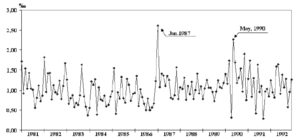 Graph of Down syndrome cases in Belarus around the time of Chernobyl
Graph of Down syndrome cases in Belarus around the time of Chernobyl
- Down syndrome (trisomy 21). In West Berlin, Germany, prevalence of Down syndrome (trisomy 21) peaked 9 months following the main fallout.[11, 12][citation needed] Between 1980 and 1986, the birth prevalence of Down syndrome was quite stable (i.e., 1.35–1.59 per 1,000 live births [27–31 cases]).[citation needed] In 1987, 46 cases were diagnosed (prevalence = 2.11 per 1,000 live births). Most of the excess resulted from a cluster of 12 cases among children born in January 1987.[citation needed] The prevalence of Down syndrome in 1988 was 1.77, and in 1989, it reached pre-Chernobyl values. The authors[citation needed] noted that the isolated geographical position of West Berlin before reunification, the free genetic counseling, and complete coverage of the population through one central cytogenetic laboratory support completeness of case ascertainment; in addition, constant culture preparation and analysis protocols ensure a high quality of data.[citation needed]
- Chromosomal aberrations. Reports of structural chromosome aberrations in people exposed to fallout in Belarus and other parts of the former Soviet Union, Austria, and Germany argue against a simple dose-response relationship between degree of exposure and incidence of aberrations.[citation needed] These findings are relevant because a close relationship exists between chromosome changes and congenital malformations. Inasmuch as some types of aberration are almost specific for ionizing radiation, researchers use aberrations to assess exposure dose. On the basis of current coefficients, however, it is not certain that the calculated individual exposure doses resulting from fallout would not induce measurable rates of chromosome aberrations.[citation needed]
- Neural tube defects (NTDs) in Turkey. During the embryonic phase of fetal development, the neural tube differentiates into the brain and spinal cord (i.e., collectively forming the central nervous system). Chemical or physical interactions with this process can cause NTDs. Common features of this class of malformations are more or less extended fissures, often accompanied by consecutive dislocation of central nervous system (CNS) tissue. NTDs include spina bifida occulta and aperta, encephalocele, and—in the extreme case—anencephaly. The first evidence in support of a possible association between CNS malformations and fallout from Chernobyl was published by Akar et al.. in 1988.[citation needed] The Mustafakemalpasa State Hospital, Bursa region, covers a population of approximately 90,000. Investigators have documented the prevalence of malformations since 1983.[citation needed] The prevalence of NTDs was 1.7 to 9.2 per 1,000 births, but during the first 6 months of 1987 increased to 20 per 1,000 (12 cases). The excess was most pronounced for the subgroup of anencephalics, in which prevalence increased 5-fold (i.e., 10 per 1,000 [6 cases]). In the consecutive months that followed (i.e., July–December 1987), the prevalence decreased again (1.3 per 1,000 for all NTDs, 0.6 per 1,000 for anencephaly), and it reached pre-Chernobyl levels during the first half of 1988 (all NTDs: 0.6 per 1,000; anencephaly: 0.2 per 1,000). This initial report was supported by several similar findings in observational studies from different regions of Turkey.[citation needed]
Economic cost
While it is difficult to establish the total economic cost of the disaster, in Belarus the total cost over 30 years is estimated at US$235 billion (in 2005 dollars).[109] The on-going costs are, however, better defined; in their 2003–2005 report, The Chernobyl Forum stated that between 5% and 7% of government spending in Ukraine still related to Chernobyl, while in Belarus over $13 billion is thought to have been spent between 1991 and 2003, with 22% of national budget having been Chernobyl-related in 1991, falling to 6% by 2002.[109] Much of the current cost related to the payment of Chernobyl-related social benefits to some 7 million people across the 3 countries.[109]
A significant economic impact at the time was the removal of 784,320 ha (1,938,100 acres) of agricultural land and 694,200 ha (1,715,000 acres) of forest from production. While much of this has been returned to use, agricultural production costs have risen due to the need for special cultivation techniques, fertilizers and additives.[109]
Chernobyl after the disaster
Main article: Chernobyl after the disasterFollowing the accident, questions arose about the future of the plant and its eventual fate. All work on the unfinished reactors 5 and 6 was halted three years later. However, the trouble at the Chernobyl plant did not end with the disaster in reactor 4. The damaged reactor was sealed off and 200 cubic meters (260 cu yd) of concrete was placed between the disaster site and the operational buildings.[citation needed] The Ukrainian government continued to let the three remaining reactors operate because of an energy shortage in the country. In 1991, a fire broke out in the turbine building of reactor 2;[119] the authorities subsequently declared the reactor damaged beyond repair and had it taken offline. Reactor 1 was decommissioned in November 1996 as part of a deal between the Ukrainian government and international organizations such as the IAEA to end operations at the plant. On 15 December 2000, then-President Leonid Kuchma personally turned off Reactor 3 in an official ceremony, shutting down the entire site.[120]
In 2011, Ukraine plans to open up the sealed zone around the Chernobyl reactor to tourists who wish to learn more about the tragedy that occurred in 1986.[121]
Recovery projects
The Chernobyl Shelter Fund
The Chernobyl Shelter Fund was established in 1997 at the Denver 23rd G8 summit to finance the Shelter Implementation Plan (SIP). The plan calls for transforming the site into an ecologically safe condition by means of stabilization of the sarcophagus followed by construction of a New Safe Confinement (NSC). While the original cost estimate for the SIP was US$768 million, the 2006 estimate was $1.2 billion. The SIP is being managed by a consortium of Bechtel, Battelle, and Electricité de France, and conceptual design for the NSC consists of a movable arch, constructed away from the shelter to avoid high radiation, to be slid over the sarcophagus. The NSC is expected to be completed in 2013, and will be the largest movable structure ever built.
Dimensions:
- Span: 270 m (886 ft)
- Height: 100 m (330 ft)
- Length: 150 m (492 ft)
The United Nations Development Programme
The United Nations Development Programme has launched in 2003 a specific project called the Chernobyl Recovery and Development Programme (CRDP) for the recovery of the affected areas.[122] The programme was initiated in February 2002 based on the recommendations in the report on Human Consequences of the Chernobyl Nuclear Accident. The main goal of the CRDP’s activities is supporting the Government of Ukraine in mitigating long-term social, economic, and ecological consequences of the Chernobyl catastrophe. CRDP works in the four most Chernobyl-affected areas in Ukraine: Kyivska, Zhytomyrska, Chernihivska and Rivnenska.
The International Project on the Health Effects of the Chernobyl Accident
The International Project on the Health Effects of the Chernobyl Accident (IPEHCA) was created and received US $20 million, mainly from Japan, in hopes of discovering the main cause of health problems due to 131I radiation. These funds were divided between Ukraine, Belarus, and Russia, the three main affected countries, for further investigation of health effects. As there was significant corruption in former Soviet countries, most of the foreign aid was given to Russia, and no positive outcome from this money has been demonstrated.[citation needed]
Cultural impact
Main articles: Cultural impact of Chernobyl disaster and Nuclear power debateThe Chernobyl accident attracted a great deal of interest. Because of the distrust that many people (both within and outside the USSR) had in the Soviet authorities, a great deal of debate about the situation at the site occurred in the first world during the early days of the event. Because of defective intelligence based on photographs taken from space, it was thought that unit number three had also suffered a dire accident.
Journalists mistrusted many professionals (such as the spokesman from the UK NRPB), and in turn encouraged the public to mistrust them.[123]
In Italy, the Chernobyl accident was reflected in the outcome of the 1987 referendum. As a result of that referendum, Italy began phasing out its nuclear power plants in 1988, a decision that was effectively reversed in 2008.
In anime and video games
In 1995 Japanese animator Hayao Miyazaki wrote and directed "On Your Mark", a music video for Japanese pop duo Chage & Aska. This was essentially an animated music video lasting almost seven minutes. The opening scene shows a clean, old-fashioned and apparently deserted small village which is dominated by a huge, asymmetrical version of the Chernobyl "sarcophagus." In an interview in "Animage" magazine in 1995, Miyazaki compared the sarcophagus in the video to Chernobyl, noting the survival of plant life.[124]
The "S.T.A.L.K.E.R" series of video games is set in the Chernobyl Exclusion Zone.[125]
Commemoration
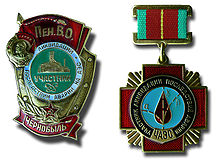 Soviet badge awarded to liquidators
Soviet badge awarded to liquidators
The Front Veranda (1986), a lithograph by Susan Dorothea White in the National Gallery of Australia, exemplifies worldwide awareness of the event. Heavy Water: A film for Chernobyl was released by Seventh Art in 2006 to commemorate the disaster through poetry and first-hand accounts.[126] The film secured the Cinequest Award as well as the Rhode Island "best score" award[127] along with a screening at Tate Modern.[128]
Chernobyl Way is an annual rally run on 26 April by the opposition in Belarus as a remembrance of the Chernobyl disaster.
Chernobyl 20
This exhibit presents the stories of 20 people who have each been affected by the disaster, and each person's account is written on a panel. The 20 individuals whose stories are related in the exhibition are from Belarus, France, Latvia, Russia, Sweden, Ukraine, and the United Kingdom.
Developed by Danish photo-journalist Mads Eskesen, the exhibition is prepared in multiple languages including English, German, Danish, Dutch, Russian, and Ukrainian.
In Kiev, Ukraine, the exhibition was launched at the "Chernobyl 20 Remembrance for the Future" conference on 23 April 2006. It was then exhibited during 2006 in the United States, Australia, Denmark, the Netherlands, Switzerland, Ukraine, and the United Kingdom.
See also
- Chernobyl compared to other radioactivity releases
- Chernobyl Nuclear Power Plant Exclusion Zone
- Chernobyl Shelter Fund
- Children of Chernobyl Benefit Concert
- List of Chernobyl-related articles
- Nuclear energy policy of the United States#Public opinion after Chernobyl
- National Geographic Seconds From Disaster episodes
- Threat of the Dnieper reservoirs
- Zero Hour (TV series) episode, showing the inside of the power plant with remarkable accuracy
Notes
- ^ "No one believed the first newspaper reports, which patently understated the scale of the catastrophe and often contradicted one another. The confidence of readers was re-established only after the press was allowed to examine the events in detail without the original censorship restrictions. The policy of openness (glasnost) and 'uncompromising criticism' of outmoded arrangements had been proclaimed back at the 27th Congress (of KPSS), but it was only in the tragic days following the Chernobyl disaster that glasnost began to change from an official slogan into an everyday practice. The truth about Chernobyl which eventually hit the newspapers opened the way to a more truthful examination of other social problems. More and more articles were written about drug abuse, crime, corruption and the mistakes of leaders of various ranks. A wave of 'bad news' swept over the readers in 1986-87, shaking the consciousness of society. Many were horrified to find out about the numerous calamities of which they had previously had no idea. It often seemed to people that there were many more outrages in the epoch of perestroika than before although, in fact, they had simply not been informed about them previously." -Kagarlitsky pp 333–334
- ^ "The mere fact that the operators were carrying out an experiment that had not been approved by higher officials indicates that something was wrong with the chain of command. The State Committee on Safety in the Atomic Power Industry is permanently represented at the Chernobyl station. Yet the engineers and experts in that office were not informed about the program. In part, the tragedy was the product of administrative anarchy or the attempt to keep everything secret." Medvedev, Z., pp. 18–20
References
- ^ Black, Richard (2011-04-12). "''Fukushima: As Bad as Chernobyl?''". Bbc.co.uk. http://www.bbc.co.uk/news/science-environment-13048916. Retrieved 2011-08-20.
- ^ From interviews with Mikhail Gorbachev, Hans Blix and Vassili Nesterenko. The Battle of Chernobyl. Discovery Channel. Relevant video locations: 31:00, 1:10:00.
- ^ "Frequently Asked Chernobyl Questions". International Atomic Energy Agency - Division of Public Information. May 2005. http://www.iaea.org/newscenter/features/chernobyl-15/cherno-faq.shtml. Retrieved 23 March 2011.
- ^ "Table 2.2 Number of people affected by the Chernobyl accident (to December 2000)" (PDF). The Human Consequences of the Chernobyl Nuclear Accident. UNDP and UNICEF. 22 January 2002. p. 32. http://www.unicef.org/newsline/chernobylreport.pdf. Retrieved 17 September 2010.
- ^ "Table 5.3: Evacuated and resettled people" (PDF). The Human Consequences of the Chernobyl Nuclear Accident. UNDP and UNICEF. 22 January 2002. p. 66. http://www.unicef.org/newsline/chernobylreport.pdf. Retrieved 17 September 2010.
- ^ ICRIN Project (2011). International Chernobyl Portal chernobyl.info. http://chernobyl.info/Default.aspx?tabid=294. Retrieved 2011.
- ^ a b Environmental consequences of the Chernobyl accident and their remediation: Twenty years of experience. Report of the Chernobyl Forum Expert Group ‘Environment’. Vienna: International Atomic Energy Agency. 2006. p. 180. ISBN 92–0–114705–8. http://www-pub.iaea.org/MTCD/publications/PDF/Pub1239_web.pdf. Retrieved 13 March 2011.
- ^ Kagarlitsky, Boris (1989). "Perestroika: The Dialectic of Change". In Mary Kaldor, Gerald Holden, Richard A. Falk. The New Detente: Rethinking East-West Relations. United Nations University Press. ISBN 0860919625.
- ^ Associated Press, 24 April 2006, at msnbc.msn.com
- ^ a b Hallenbeck, William H (1994). Radiation Protection. CRC Press. p. 15. ISBN 0-873-719-964. "Reported thus far are 237 cases of acute radiation sickness and 31 deaths."
- ^ "Chernobyl: the true scale of the accident". Chernobyl’s Legacy: Health, Environmental and Socio-Economic Impacts. http://www.who.int/mediacentre/news/releases/2005/pr38/en/index.html. Retrieved 2011-04-15.
- ^ a b "Torch: The Other Report On Chernobyl- executive summary". European Greens and UK scientists Ian Fairlie PhD and David Sumner - Chernobylreport.org. April 2006. http://www.chernobylreport.org/?p=summary. Retrieved 2011-08-20.
- ^ a b c "The Chernobyl Catastrophe - Consequences on Human Health". Greenpeace. 18 April 2006. http://www.greenpeace.org/international/Global/international/planet-2/report/2006/4/chernobylhealthreport.pdf. Retrieved 15 December 2008.
- ^ a b Alexey V. Yablokov; Vassily B. Nesterenko; Alexey V. Nesterenko (2009). Chernobyl: Consequences of the Catastrophe for People and the Environment (Annals of the New York Academy of Sciences) (paperback ed.). Wiley-Blackwell. ISBN 978-1573317573.
- ^ a b c d e f g h i j k l m n o p Medvedev, Zhores A. (1990). The Legacy of Chernobyl (paperback ed.). W. W. Norton & Company. ISBN 978-0393308143.
- ^ This need to cool reactors during a shutdown later played a key role in the Fukushima I nuclear accidents.
- ^ <Please add first missing authors to populate metadata.> (January 1996) (PDF). DOE Fundamentals Handbook — Nuclear physics and reactor theory. 1 of 2, module 1. United States Department of Energy. p. 61. http://www.hss.doe.gov/nuclearsafety/ns/techstds/standard/hdbk1019/h1019v1.pdf#page=85.5. Retrieved 3 June 2010.[dead link]
- ^ "Standard Review Plan for the Review of Safety Analysis Reports for Nuclear Power Plants: LWR Edition (NUREG-0800)". United States Nuclear Regulatory Commission. May 2010. http://www.nrc.gov/reading-rm/doc-collections/nuregs/staff/sr0800/. Retrieved 2 June 2010.
- ^ NV Karpan: 312–13.
- ^ a b c d e f g h i "IAEA Report INSAG-7 Chernobyl Accident: Updating of INSAG-1 Safety Series, No.75-INSAG-7". Vienna: International Atomic Energy Agency. 1992. http://www-pub.iaea.org/MTCD/publications/PDF/Pub913e_web.pdf.
- ^ A.S.Djatlov:30
- ^ "The official program of the test" (in Russian). http://rrc2.narod.ru/book/app7.html.
- ^ A.S.Djatlov:31
- ^ "What Happened at Chernobyl?". Nuclear Fissionary. http://nuclearfissionary.com/2010/03/03/what-happened-at-chernobyl/. Retrieved 12 January 2011.
- ^ The accumulation of Xenon-135 in the core is burned out by neutrons. Thus, higher power settings, associated with higher neutron flux, burn the xenon out more quickly. Conversely, low power settings result in the accumulation of xenon.
- ^ The information on accident at the Chernobyl NPP and its consequences, prepared for IAEA, Atomic Energy, v. 61, 1986, p. 308-320.
- ^ The RBMK is a boiling water reactor, so in-core boiling is normal at higher power levels. The RBMK design has a negative void coefficient above 700 MW.
- ^ N.V.Karpan:349
- ^ E. O. Adamov; Yu. M. Cherkashov, et al. (2006) (in Russian). Channel Nuclear Power Reactor RBMK (Hardcover ed.). Moscow: GUP NIKIET. ISBN 5-98706-018-4. http://accidont.ru/book.html.
- ^ Dyatlov, Anatoly (in Russian). Chernobyl. How did it happen?. http://rrc2.narod.ru/book/gl4.html.
- ^ "Chernobyl as it was – 2" (in Russian). http://www.reactors.narod.ru/pub/chern_2/chern_2.htm.
- ^ Davletbaev, RI (1995) (in Russian). Last shift Chernobyl. Ten years later. Inevitability or chance?. Moscow: Energoatomizdat. ISBN 5-283-03618-9. http://accidont.ru/Davlet.html.
- ^ a b Pakhomov, Sergey A; Yuri V. Dubasov (16 December 2009). "Estimation of Explosion Energy Yield at Chernobyl NPP Accident". Pure and Applied Geophysics (Springerlink.com) 167 (4–5): 575. doi:10.1007/s00024-009-0029-9.
- ^ "Chernobyl: Assessment of Radiological and Health Impact (Chapter 1)". Nuclear Energy Agency. http://www.nea.fr/html/rp/chernobyl/c01.html. Retrieved 2011-08-20.
- ^ Checherov, K.P. (25–7 November 1998) (in Russian). Development of ideas about reasons and processes of emergency on the 4-th unit of Chernobyl NPP 26.04.1986. Slavutich, Ukraine: International conference "Shelter-98".
- ^ B. Medvedev (June 1989). "JPRS Report: Soviet Union Economic Affairs Chernobyl Notebook". Novy Mir. http://dodreports.com/pdf/ada335076.pdf. Retrieved 27 March 2011.
- ^ "Cross-sectional view of the RBMK-1000 main building". http://www.neimagazine.com/journals/Power/NEI/March_2006/attachments/RBMK1000Key.jpg. Retrieved 11 September 2010.
- ^ Medvedev, Grigori (1989). The Truth About Chernobyl (Hardcover ed.). VAAP. ISBN 2-226-04031-5.
- ^ National Geographic (2004). Meltdown in Chernobyl (Video).
- ^ Shcherbak, Y (1987). Chernobyl. 6. Yunost. In Medvedev, Z. p. 44.
- ^ Adam Higginbotham (26 March 2006). "Adam Higginbotham: Chernobyl 20 years on | World news | The Observer". London: Guardian. http://www.guardian.co.uk/world/2006/mar/26/nuclear.russia. Retrieved 22 March 2010.
- ^ Mil Mi-8 crash near Chernobyl (Video). 2006. http://www.youtube.com/watch?v=aw-ik1U4Uvk.
- ^ a b c "''Special Report: 1997: Chernobyl: Containing Chernobyl?''". BBC News. 1997-11-21. http://news.bbc.co.uk/2/hi/special_report/1997/chernobyl/33005.stm. Retrieved 2011-08-20.
- ^ Zeilig, Martin (August/September 1995). "Louis Slotin And 'The Invisible Killer'". The Beaver 75 (4): 20–27. http://www.mphpa.org/classic/FH/LA/Louis_Slotin_1.htm. Retrieved 28 April 2008.
- ^ "Веб публикация статей газеты". Swrailway.gov.ua. http://www.swrailway.gov.ua/rabslovo/?aid=62. Retrieved 22 March 2010.
- ^ "Методическая копилка" (in russian). Surkino.edurm.ru. http://surkino.edurm.ru/p4aa1.html. Retrieved 22 March 2010.
- ^ a b (Russian) Video footage of Chornobyl disaster on April 28
- ^ (English) American TV-footage about Chornobyl
- ^ "Chernobyl haunts engineer who alerted world". CNN Interactive World News (Cable News Network, Inc.). 26 April 1996. http://www.cnn.com/WORLD/9604/26/chernobyl/230pm/index2.html. Retrieved 28 April 2008.
- ^ a b c d e f g h i j k l m n o p q "Interview of Valentyna Shevchenko to "Young Ukraine" (Ukrainian Pravda)". Istpravda.com.ua. April 25, 2011. http://www.istpravda.com.ua/articles/2011/04/25/36971/. Retrieved 2011-08-20.
- ^ (Ukrainian) Presidential Decree #501/2011 "For distinguishing with the state awards of Ukraine"
- ^ (Ukrainian) Presidential Decree #502/2011 "For distinguishing with the state awards of Ukraine the citizens of foreign countries"
- ^ a b Bogatov, S.; A. Borovoi, A. Lagunenko, E. Pazukhin, V. Strizhov, V. Khvoshchinskii (1 December 2008). "Formation and spread of Chernobyl lavas". Radiochemistry 50 (6): 650–654. doi:10.1134/S1066362208050131.
- ^ Petrov, Yu.; Yu. Udalov, J. Subrt, S. Bakardjieva, P. Sazavsky, M. Kiselova, P. Selucky, P. Bezdicka, C. Jorneau, P. Piluso (1 April 2009). "Behavior of melts in the UO2-SiO2 system in the liquid-liquid phase separation region". Glass Physics and Chemistry 35 (2): 199–204. doi:10.1134/S1087659609020126.
- ^ Journeau, C.; E. Boccaccio, C. Jégou, P. Piluso, G. Cognet (2001). Flow and Solidification of Corium in the VULCANO facility. http://www.plinius.eu/home/liblocal/docs/Flow_Solidification_VULCANO.pdf.
- ^ Mevedev Z. (1990):58-59
- ^ Chernobyl: The End of the Nuclear Dream, 1986, p.178, by Nigel Hawkes et al., ISBN 0-330-29743-0
- ^ Sattonnay, G.; C. Ardois, C. Corbel, J. F. Lucchini, M. -F. Barthe, F. Garrido, D. Gosset (2001-01). "Alpha-radiolysis effects on UO2 alteration in water". Journal of Nuclear Materials 288 (1): 11–19. doi:10.1016/S0022-3115(00)00714-5. http://www.sciencedirect.com/science?_ob=ArticleURL&_udi=B6TXN-42993M3-3&_user=10&_rdoc=1&_fmt=&_orig=search&_sort=d&_docanchor=&view=c&_searchStrId=987276167&_rerunOrigin=scholar.google&_acct=C000050221&_version=1&_urlVersion=0&_userid=10&md5=176c731b3153a03f1c27bc6f948bd647. Retrieved 21 August 2009.
- ^ Clarens, F.; J. de Pablo, I. Diez-Perez, I. Casas, J. Gimenez, M. Rovira (1 December 2004). "Formation of Studtite during the Oxidative Dissolution of UO2 by Hydrogen Peroxide: A SFM Study". Environmental Science & Technology 38 (24): 6656–6661. doi:10.1021/es0492891.
- ^ Burakov, B. E.; E. E. Strykanova, E. B. Anderson (1997). "Secondary Uranium Minerals on the Surface of Chernobyl" Lava"". Materials Research Society Symposium Proceedings. 465. pp. 1309–1312.
- ^ Burns, P. C; K. A Hughes (2003). "Studtite, (UO2)(O2)(H2O)2(H2O)2: The first structure of a peroxide mineral". American Mineralogist 88: 1165–1168. http://www.kubatko.com/studtitestructure.pdf.
- ^ The Social Impact of the Chernobyl Disaster, 1988, p166, by David R. Marples ISBN 0-333-48198-4
- ^ "Chernobyl's silent graveyards". BBC News Online. 20 April 2006. http://news.bbc.co.uk/2/shared/spl/hi/pop_ups/06/in_pictures_chernobyl0s_silent_graveyards_/html/1.stm.
- ^ IAEA Report INSAG-1 (International Nuclear Safety Advisory Group). Summary Report on the Post-Accident Review on the Chernobyl Accident. Safety Series No. 75-INSAG-1.IAEA, Vienna, 1986.
- ^ a b c "Expert report to the IAEA on the Chernobyl accident" (in Belarusian). Atomic Energy. 1986. http://accidont.ru/expert.html.
- ^ "NEI Source Book: Fourth Edition (NEISB_3.3.A1)". Insc.anl.gov. http://www.insc.anl.gov/neisb/neisb4/NEISB_3.3.A1.html. Retrieved 31 July 2010.
- ^ Marples, David R. (1991). Ukraine Under Perestroika: Ecology, Economics and the Workers' Revolt. Basingstoke, Hampshire: MacMillan Press. pp. 50–51,76.
- ^ "Malformations in a chornobyl-impacted region". www.ncbi.nlm.nih.gov. 2011-03-18. http://www.ncbi.nlm.nih.gov/pubmed/20308207. Retrieved 2011-08-20.
- ^ "Chronic radiation exposure in the Rivne-Polissia region of Ukraine: implications for birth defects". Ncbi.nlm.nih.gov. 2011-03-18. http://www.ncbi.nlm.nih.gov/pubmed/20737614. Retrieved 2011-08-20.
- ^ Developmental Instability of Plants and Radiation from Chernobyl (www.jstor.org)
- ^ "Elevated frequency of abnormalities in barn swallows from Chernobyl.". www.ncbi.nlm.nih.gov. 2011-03-18. http://www.ncbi.nlm.nih.gov/pubmed/17439847. Retrieved 2011-08-20.
- ^ "Cleft lip and cleft palate birth rate in Bavaria before and after the Chernobyl nuclear power plant accident". www.ncbi.nlm.nih.gov. 2011-03-18. http://www.ncbi.nlm.nih.gov/pubmed/15045533. Retrieved 2011-08-20.
- ^ "WHO Report on Chernobyl Health Effects 2006 -Health Effects of the Chernobyl Accident and Special Health Care Programmes" (PDF). WHO. 2006. http://whqlibdoc.who.int/publications/2006/9241594179_eng.pdf. Retrieved 2011-08-20.
- ^ "Ten years after Chernobyl : What do we really know?". Iaea.org. 1997-09-21. http://www.iaea.org/Publications/Booklets/Chernoten/facts.html. Retrieved 2011-08-20.
- ^ Marples, David R. (1996) "Chernobyl: The Decade of Despair" in Bulletin of the Atomic Scientists May 1996. p. 20.
- ^ "Tchernobyl, 20 ans après" (in French). RFI. 24 April 2006. http://www.rfi.fr/actufr/articles/076/article_43250.asp. Retrieved 24 April 2006.
- ^ "Path and extension of the radioactive cloudl" (in French). IRSN. http://www.irsn.fr/FR/popup/Pages/tchernobyl_animation_nuage.aspx. Retrieved 16 December 2006.
- ^ IAEA Bulletin Autumn 1986PDF (0.38 MB)
- ^ Mould, Richard Francis (2000). Chernobyl Record: The Definitive History of the Chernobyl Catastrophe. CRC Press. p. 48. ISBN 0-750-306-70X.
- ^ Ympäristön Radioaktiivisuus Suomessa — 20 Vuotta TshernobylistaPDF (7.99 MB)
- ^ "Deposition of radionuclides on soil surfaces 3.1.5". http://www-pub.iaea.org/MTCD/publications/PDF/Pub1239_web.pdf.
- ^ Gray, Richard (22 April 2007). "How we made the Chernobyl rain". Telegraph (London). http://www.telegraph.co.uk/news/worldnews/1549366/How-we-made-the-Chernobyl-rain.html. Retrieved 27 November 2009.
- ^ "Chernobyl Accident". World Nuclear Association. May 2008. http://world-nuclear.org/info/chernobyl/inf07.html. Retrieved 18 June 2008.
- ^ Dederichs, H.; Pillath, J.; Heuel-Fabianek, B.; Hill, P.; Lennartz, R. (2009). "Langzeitbeobachtung der Dosisbelastung der Bevölkerung in radioaktiv kontaminierten Gebieten Weißrusslands - Korma-Studie. Vol. 31, series "Energy & Environment" by Forschungszentrum Jülich". Hdl.handle.net. http://juwel.fz-juelich.de:8080/dspace/handle/2128/3551. Retrieved 30 January 2011.
- ^ "Conséquences de la catastrophe de Tchernobyl en France" (in French). French-speaking Wikipedia. http://fr.wikipedia.org/wiki/Cons%C3%A9quences_de_la_catastrophe_de_Tchernobyl_en_France. Retrieved 18 March 2011.
- ^ "'Radioactive boars' on loose in Germany". Agence France Presse. August 2010. http://sg.news.yahoo.com/afp/20100807/tts-germany-hunting-food-chernobyl-509a08e.html. Retrieved 9 August 2010.[dead link]
- ^ Chernobyl source term, atmospheric dispersion, and dose estimation, EnergyCitationsDatabase, 1 November 1989
- ^ a b OECD Papers Volume 3 Issue 1, OECD, 2003
- ^ "Unfall im japanischen Kernkraftwerk Fukushima". ZAMG. 24 March 2011. http://www.zamg.ac.at/aktuell/index.php?seite=1&artikel=ZAMG_2011-03-24GMT11:24. Retrieved 2011-08-20.
- ^ "Fukushima radioactive water could overflow soon". Asahi.com. 2011-06-04. http://www.asahi.com/english/TKY201106040157.html. Retrieved 2011-08-20.
- ^ Mould 2000, p. 29. "The number of deaths in the first three months were 31[.]"
- ^ a b c d Chernobyl: Catastrophe and Consequences, Springer, Berlin ISBN 3-540-23866-2
- ^ a b Kryshev, I.I., Radioactive contamination of aquatic ecosystems following the Chernobyl accident. Journal of Environmental Radioactivity, 1995. 27: p. 207-219
- ^ EURATOM Council Regulations No. 3958/87, No. 994/89, No. 2218/89, No. 770/90
- ^ Fleishman, D.G., et al., Cs-137 in fish of some lakes and rivers of the Bryansk region and North-West Russia in 1990–1992. Journal of Environmental Radioactivity, 1994. 24: p. 145-158
- ^ a b "Environmental consequences of the Chernobyl accident and their remediation"PDF IAEA, Vienna
- ^ Wildlife defies Chernobyl radiation, by Stefen Mulvey, BBC News
- ^ a b The International Chernobyl Project Technical Report, IAEA, Vienna, 1991
- ^ "Black Fungus Found in Chernobyl Eats Harmful Radiation". Foxnews.com. 2007-05-30. http://www.foxnews.com/story/0,2933,276196,00.html. Retrieved 2011-08-20.
- ^ "25 Jahre Tschernobyl: Deutsche Wildschweine immer noch verstrahlt - Nachrichten Wissenschaft - WELT ONLINE" (in (German)). Welt.de. 2011-03-18. http://www.welt.de/wissenschaft/article12874184/Deutsche-Wildschweine-immer-noch-verstrahlt.html. Retrieved 2011-08-20.
- ^ a b Rosslyn Beeby (27 Apr, 2011). "World's nuclear power industry in decline". Canberra Times. http://www.canberratimes.com.au/news/world/world/general/worlds-nuclear-power-industry-in-decline/2145234.aspx#.
- ^ 30.06.2010 (2010-06-30). "Fortsatt nedforing etter radioaktivitet i dyr som har vært på utmarksbeite - Statens landbruksforvaltning". SLF. https://www.slf.dep.no/no/erstatning/palegg-og-restriksjoner/radioaktivitet/Fortsatt+nedforing+etter+radioaktivitet+i+dyr+som+har+v%C3%A6rt+p%C3%A5+utmarksbeite.10694.cms. Retrieved 2011-08-20.
- ^ "UNSCEAR assessment of the Chernobyl accident". Unscear.org. http://www.unscear.org/unscear/en/chernobyl.html. Retrieved 31 July 2010.
- ^ "IAEA Report". In Focus: Chernobyl. International Atomic Energy Agency. Archived from the original on 17 December 2007. http://web.archive.org/web/20071217112720/http://www.iaea.org/NewsCenter/Focus/Chernobyl/index.shtml. Retrieved 29 March 2006.
- ^ "How Many Cancers Did Chernobyl Really Cause?". UCSUSA.org. 17 April 2011. http://allthingsnuclear.org/post/4704112149/how-many-cancers-did-chernobyl-really-cause-updated.
- ^ "UNSCEAR — Chernobyl health effects". Unscear.org. http://www.unscear.org/unscear/en/chernobyl.html#Health. Retrieved 23 March 2011.
- ^ Rosenthal, Elisabeth. (6 September 2005) Experts find reduced effects of Chernobyl. nytimes.com. Retrieved 14-02-08.
- ^ "Thyroid Cancer". Genzyme.ca. http://www.genzyme.ca/thera/ty/ca_en_p_tp_thera-ty.asp. Retrieved 31 July 2010.
- ^ a b c d e f g "Chernobyl's Legacy: Health, Environmental and Socia-Economic Impacts and Recommendations to the Governments of Belarus, Russian Federation and Ukraine" (PDF). International Atomic Energy Agency - The Chernobyl Forum: 2003–2005. http://www.iaea.org/Publications/Booklets/Chernobyl/chernobyl.pdf. Retrieved 31 July 2010.
- ^ "Excerpt from UNSCEAR 2001 REPORT ANNEX - Hereditary effects of radiation" (PDF). http://www.unscear.org/docs/chernobylherd.pdf. Retrieved 2011-08-20.
- ^ "Chernobyl Forum summaries". International Atomic Energy Agency. http://www-ns.iaea.org/meetings/rw-summaries/chernobyl_forum.htm. Retrieved 31 July 2010.
- ^ Mettler, Fred. "IAEA Bulletin Volume 47, No.2 - Chernobyl's Legacy". Iaea.org. http://www.iaea.org/Publications/Magazines/Bulletin/Bull472/htmls/chernobyls_legacy2.html. Retrieved 2011-08-20.
- ^ "What's the situation at Chernobyl?". Iaea.org. http://www.iaea.org/blog/Infolog/?page_id=25. Retrieved 2011-08-20.
- ^ Mettler, Fred. "Chernobyl's living legacy". Iaea.org. http://www.iaea.org/Publications/Magazines/Bulletin/Bull472/htmls/chernobyls_legacy2.html. Retrieved 2011-08-20.
- ^ http://ije.oxfordjournals.org/content/28/1/19.full.pdf
- ^ Hawley, Charles. "Greenpeace vs. the United Nations". The Chernobyl Body Count Controversy. SPIEGEL. http://www.spiegel.de/international/0,1518,411864,00.html. Retrieved 15 March 2011.
- ^ "20 years after Chernobyl — The ongoing health effects". IPPNW. April 2006. http://www.ippnw-students.org/chernobyl/research.html. Retrieved 24 April 2006.
- ^ "Details". Annals of the New York Academy of Sciences. Annals of the New York Academy of Sciences. http://www.nyas.org/publications/annals/Detail.aspx?cid=f3f3bd16-51ba-4d7b-a086-753f44b3bfc1. Retrieved 15 March 2011.
- ^ "Information Notice No. 93-71". Nrc.gov. http://www.nrc.gov/reading-rm/doc-collections/gen-comm/info-notices/1993/in93071.html. Retrieved 2011-08-20.
- ^ IAEA's Power Reactor Information System polled in May 2008 reports shut down for units 1, 2, 3 and 4 respectively at 1996/11/30, 1991/10/11, 2000/12/15 and 1986/04/26.
- ^ "News". Associated Press. Yahoo News. 13 December 2010. http://health.yahoo.net/news/s/ap/eu_ukraine_chernobyl_tourism. Retrieved 13 December 2010.
- ^ "CRDP: Chernobyl Recovery and Development Programme (United Nations Development Programme)". Undp.org.ua. http://www.undp.org.ua/?page=projects&projects=14. Retrieved 31 July 2010.
- ^ Kasperson, Roger E.; Stallen, Pieter Jan M. (1991). Communicating Risks to the Public: International Perspectives. Berlin: Springer Science and Media. pp. 160–162. ISBN 0792306015.
- ^ "Interview: Miyazaki on On Your Mark // Hayao Miyazaki Web". Nausicaa.net. http://nausicaa.net/miyazaki/interviews/m_on_oym.html. Retrieved 31 July 2010.
- ^ GSC Game World. S.T.A.L.K.E.R. Series (in English). (THQ). Windows.
- ^ "Processing the Dark: Heavy Water – A Film for Chernobyl | Movie Mail UK". Moviemail-online.co.uk. http://www.moviemail-online.co.uk/scripts/article.pl?articleID=308. Retrieved 31 July 2010.
- ^ "Blog". http://www.heavy-water.co.uk/. Retrieved 11 September 2010.
- ^ "Heavy Water: a film for Chernobyl". Atomictv.com. 26 April 1986. http://www.atomictv.com/Hwater.html. Retrieved 31 July 2010.
Further reading
- Cheney, Glenn Alan (1995). Journey to Chernobyl: Encounters in a Radioactive Zone. Academy Chicago. ISBN 0-89733-418-3. OCLC 231661295.
- Medvedev, Grigori (1989). The Truth About Chernobyl. VAAP. First American edition published by Basic Books in 1991. ISBN 2-226-04031-5 (Hardcover).
- Medvedev, Zhores A. (1990). The Legacy of Chernobyl (paperback ed.). W. W. Norton & Company. ISBN 978-0393308143.
- Read, Piers Paul (1993). Ablaze! The Story of Chernobyl. Random House UK (paperback 1997).. ISBN 978-0749316334 (paperback).
- Shcherbak, Yurii (1991) (in Russian). Chernobyl. Sowiet Writers. ISBN 0312030975. http://www.x-libri.ru/elib/sherb000/index.htm.
- Dyatlov, Anatoly (2003) (in Russian). Chernobyl. How did it happen.. Nauchtechlitizdat, Moscow.. ISBN 5-93728-006-7 (paperback).
- Karpan, Nikolaj V. (2006) (in Russian). Chernobyl. Vengeance of peaceful atom.. IKK “Balance Club”, Dnepropetrovsk.. ISBN 966-8135-21-0 (paperback).
- Hoffmann, Wolfgang (2001). Fallout From the Chernobyl Nuclear Disaster and Congenital Malformations in Europe. Archives of Environmental Health.
- Abbott, Pamela (2006). Chernobyl: Living With Risk and Uncertainty. Health, Risk & Society 8.2. pp. 105–121.
- Cohen, Bernard Leonard (1990). "(7) The Chernobyl accident — can it happen here?". The Nuclear Energy Option: An Alternative for the 90's. Plenum Press. ISBN 978-0306435676. http://www.phyast.pitt.edu/~blc/chapter7.html.[dead link]
Documents
The source documents, which relate to the emergency, published in unofficial sources:
External links
- Official UN Chernobyl site
- International Chernobyl Portal chernobyl.info, UN Inter-Agency Project ICRIN
- Frequently Asked Chernobyl Questions, by the IAEA
- Chernobyl Recovery and Development Programme (United Nations Development Programme)
- Photographs from inside the zone of alienation and City of Prypyat (2010)
- Photographs from inside the Chernobyl Reactor and City of Prypyat
- Photographs of those affected by the Chernobyl Disaster
- Photographs from the City of Pripyat, and of those affected by the disaster
- EnglishRussia Photos of a RBMK-based power plant, showing details of the reactor hall, pumps, and the control room
- The Battle of Chernobyl (documentary)
- 25 years of satellite imagery over Chernobyl
Coordinates: 51°23′22″N 30°05′56″E / 51.38944°N 30.09889°E
Categories:- Chernobyl disaster
- Civilian nuclear power accidents
- Disasters in Ukraine
- Disasters in the Soviet Union
- Energy in Ukraine
- Health in Ukraine
- History of Belarus (1945–1990)
- History of the Soviet Union and Soviet Russia
- Industrial accidents and incidents
- Industrial fires and explosions
- Nuclear accidents
- 1986 in the environment
- 1986 in the Soviet Union
- 1986 health disasters
- 20th-century explosions
Wikimedia Foundation. 2010.

